Car Musings (2015)
More recent Car Musings can be found here.
Black Beauties: My wife's cousin is married to Jim, a consummate car guy. Recently, he acquired a new toy - a 1932 full-fendered Ford rumble-seat roadster, done up as an early 1950s street rod:
The flathead engine is hopped up with dual carbs and other goodies. The original wire wheels are painted a bright red, contrasting with the black paint.
It's a beauty. The Ford will spend its winters in Arizona and summers in Montana. I wish Jim many happy miles of rides. He also has another black beauty - a '55 Ford Fairlane Sunliner convertible with the 312 cu.in. V8 and three deuces:
Arriving Sooner Than You Think: Randal O'Toole, the Antiplanner, offered a logical argument for self-driving cars and wrote "the more I learn, the more I am convinced that the first self-driving cars will be for sale by 2020 and that they will be the dominant form of travel within not much more than a decade after that."
"Based on this, I find it completely reasonable to think that, by 2020, you'll be able to buy a car that is completely self-driving on many roads and streets, but that may require you to take over on some little-used roads. Moreover, I think these cars will penetrate the market much faster than pessimists think, both because companies like Uber will make them available for-hire at rates of about 25 cents a mile, and because many cars built between now and 2020 will be easily upgradable to be self-driving cars. And, contrary to some expectations, such self-driving cars should almost completely replace transit (at least, outside of New York City) within a few years after they are introduced."
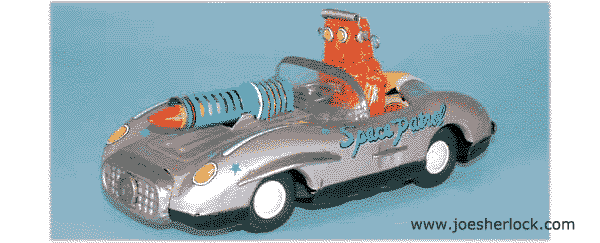
I dunno about 2020 - it's just around the corner - but I think that self-driving vehicles will arrive well before 2025. We've already got vehicles with lane change warning devices and 'smart' cruise control. Mercedes has demonstrated a self-braking car. Self-driving cars are the logical extension of these technologies.
Frankly, that's fine with me. I certainly enjoy driving on near-empty back roads but take no pleasure in navigating city traffic. Nor do I look forward to rush hour driving. I'd rather read a book. Or watch television. Or talk on the phone. With a self-driving car, I can do any - or all - of these things. Just tell the car your destination and it will get you there, using sensors, navigation software and a GPS.
Of course, a self-driving car would change everything. How can the police arrest one for being drunk if the car is doing the driving? MADD will probably go out of business. (I would hope they'd be happy to do so.) The taxi business would probably suffer - who needs a cab when your car is your own chauffeur? You could even sit in the back seat. Or take a nap.
Ever have one of those medical or dental procedures where you're told that you must bring someone along to drive you home? "Not necessary, doc. My car will get me there. Just carry me out and dump me in the back seat."
Intelligent cars can drive closer together than human-controlled vehicles. Road traffic could be denser without the need for more roads. (Lower taxes? Dare we hope?!) Self-driving cars would bring to an end to pokey drivers and road hogs, too.
If this were the Good Old Days, J.C. Whitney would already be offering an Amazing Self-Driving Conversion Kit in their catalog for $49.95. "E-Z to install - takes only minutes! No special tools required! Fits all cars except Hudson and Kaiser." Yeah, send me one of those ... and a Winky the Cat, too.
 If I Want To Sit Up High ... I'll use the handicapped stall in a men's room. Or take a ride in my old, tall Plymouth. If I Want To Sit Up High ... I'll use the handicapped stall in a men's room. Or take a ride in my old, tall Plymouth.
"Baby boomers emptying the nest and their adult offspring starting families are driving demand for sport utility vehicles, which will account for two in five new auto sales in the U.S. by 2020, according to Ford."
Boomers who pioneered the SUV a quarter century ago "feel more comfortable on the road" in them because they ride high and are easier to get into and out of than low-riding sedans. Millennials who grew up in the back seat of SUVs see them as the family car of the modern age. And now that they are having children, millennials are moving out of small sedans and into SUVs.
The return of the SUV has caused car sales to plummet. Family sedans like the Toyota Camry and Honda Accord and small cars like the Ford Focus were considered "the heart of the market" a few years ago.
The Ford Escape is the second-best-selling small SUV on the market, behind the Honda CR-V. That is the SUV segment where Ford sees the most growth potential as boomers and millennials increasingly turn to those roomy rides. The 2017 Escape, introduced at the LA Auto Show, has been restyled and mechanically tweaked. All 2017 Escape engines are paired with a six-speed automatic transmission and SE and Titanium models with turbocharged engines can be equipped with all-wheel drive.
This elevated seating fetish reminds me of George Costanza's fondness for handicapped toilets on 'Seinfeld': "I love that bathroom. It's got that high, high toilet. I feel like a gargoyle perched on the ledge of a building." (posted 11/18/15, permalink)
One Millionth Plymouth: The Plymouth automobile made its public debut in 1928. Despite the severe economic effects of the Great Depression, by 1934, over one million examples had been sold to the public - quite an accomplishment.
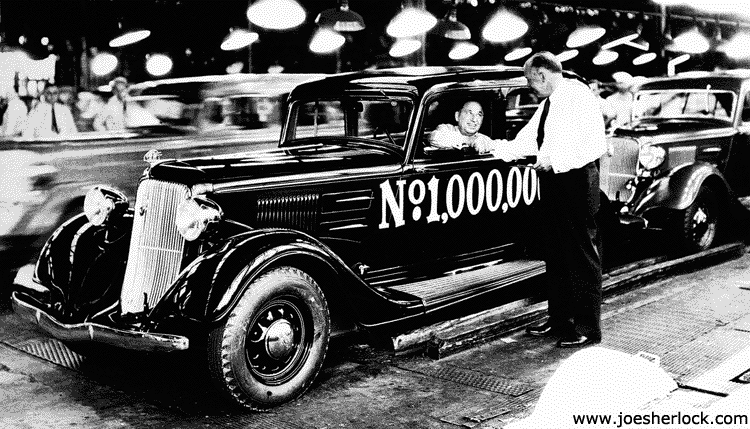
In this 1934 photo, Walter P. Chrysler shakes hands with his company's Vice President, Bernard Edwin Hutchinson, as Hutchinson drives the one-millionth Plymouth off the production line.
Yesterday, there was a Plymouth driving ahead of me - a white Breeze sedan. It's been a long time since I've seen a 'modern Plymouth' on the road around these parts. I still see Oldsmobiles from time to time, cruising down the highway. (posted 11/12/15, permalink)
Not My Style: At the Tokyo Motor Show, Lexus unveiled the LS-FC concept car. The 209-inch long flagship barge - which is about as long as a 1995 Cadillac DeVille Concours - "boasts a hydrogen power plant to drive all of its wheels, an "advanced human interface" to recognize hand gestures, and a spindle grille the size of Rhode Island.
The concept shows the direction Lexus designers may take for its future full-size sedan, including floating L-shaped lights in front and back."
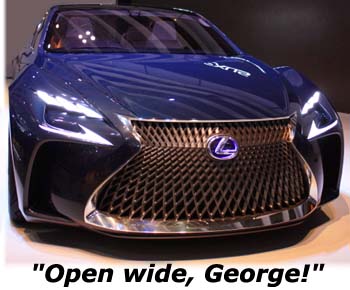 According to the automaker, many of the car's styling cues could make it into the next production version of the LS. Including that enormous spindle grille which I find distinctively hideous. According to the automaker, many of the car's styling cues could make it into the next production version of the LS. Including that enormous spindle grille which I find distinctively hideous.
Which reminds me of a story ...
One of the coolest things my dad ever did was something to 'wow' my five year-old brother. The circus had come to town and all the flat cars with the animal cages were parked on a siding which my dad serviced for the railroad. He had watched the animal keepers feed the beasts and learned one of their tricks.
After work, he drove my brother to the railroad siding, walked right up to the hippo cage, looked the hippopotamus straight in the eye and said loudly, "Open wide, George!" And, on command, the hippo opened its big toothy maw expecting to be fed. My brother was amazed and the story has now become part of the Sherlock family lore. It makes for a fond remembrance.
Whenever I see the gaping front end of that LS-FC, the phrase that comes to my mind is, "Open wide, George!"
As for me, I like the looks of my 2008 Lexus LS much better and plan to keep it. In fact, it's probably my last new car. Between retirement (which reduced my business mileage substantially) and my recent illness, I haven't been driving much - the odometer still shows less than 27,000 miles after almost 8 years of ownership.
And my always-garaged LS 460 still looks, feels and smells new - not a bit like a circus animal. (posted 11/2/15, permalink)
Happy Birthday ... to the Oldsmobile Toronado, arguably one of General Motors' most ground-breaking production cars. It turned 50 this month.
At Hemmings, Daniel Strohl has written a tribute to this collectable automobile. "In mid-Sixties America, front-wheel drive represented - at the same time - automotive past and future. Many others had tried it, but their efforts seemed relegated to the history books, with the last of the bunch 30 years gone. And yet the coming tide of imported cars included many a puller-type as well as pushers. It fell, then, to Oldsmobile to bridge the gap, something it did to much acclaim with the Toronado, introduced 50 years ago."
Manufacturers of toy and model cars realized that this Olds would make a popular offering; little Toronados were produced in a variety of scales and colors:
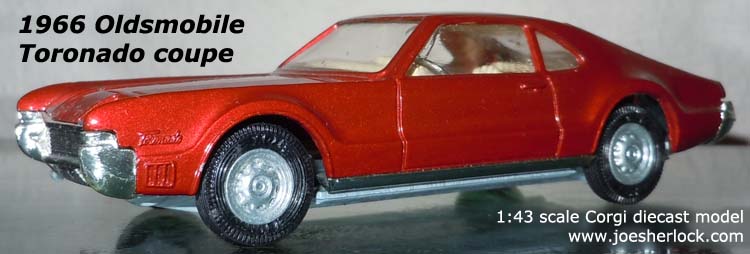
The ones made by Corgi Toys sold like hot cakes (or like spare electrical parts at a British car meet) - tens of thousands were produced during a four-year period.
Regarding the full-size Toronado, Strohl wrote: "Understandably, Oldsmobile brass felt proud of its front-wheel-drive revival car. They introduced it not with the rest of the 1966 Oldsmobile lineup in September 1965, but on its own a month later. They campaigned heavily for recognition of the car’s achievements, a campaign that resulted in Motor Trend’s Car of the Year award for 1966 as well as Car & Driver's best all-around car award and Car Life's Engineering Excellence award. Sales for that first year totaled a respectable 40,963.
Perhaps more significant, however, was the Toronado's legacy. Despite a few down years in the latter half of the Sixties, the Toronado remained in continuous production through 1992, by which time front-wheel drive had become the predominant drivetrain layout in American cars. The Toronado might not have directly influenced that transition - the longitudinal-engine front-wheel-drive layout in a full-size vehicle (as seen in the first three of the Toronado's four generations) remained an anomaly as smaller and mid-size cars adopted transverse-engine front-wheel-drive layouts - but it paved the way by reintroducing American car buyers to the idea of front-wheel drive and to its benefits."
I've posted an AutoSketch - a pen-and-ink drawing and a brief written history - of the Toronado here. I remember the excitement the car created when it was introduced. Come to think of it, the 1960s were great years for exceprional and exciting cars: the innovative but flawed Chevrolet Corvair and the elegant 1961 Lincoln Continental. The styling magic that Brooks Stevens gave to the nine year-old Studebaker platform creating the stunning 1962 Studebaker Gran Turismo Hawk.
Then there was the novel Studebaker Avanti and the gorgeous 1963 Buick Riviera. The spectacular Pontiac GTO and the incredible Corvette Sting Ray. The Sixties spawned hot-selling ponycars such as the Mustang and Camaro. And more elegant personal luxury coupes such as the sleek and crisp front-wheel drive Cadillac Eldorado and its competitor, the eye-catching 1969 Lincoln Continental Mark III. And so many more.
It's hard to believe that 50 years have passed since the delightful and innovative 1960s. Time flies. (posted 10/15/15, permalink)
Value Where it Counts: Dan Neil has tested the most recent Subaru Forester.
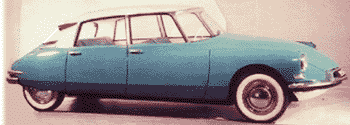 There are certain rules for making 'style' judgements: If a vehicle is made in Germany and looks a bit dull, it's admired as very Bauhausian - that old 'form follows function' scam - something that the French auto firm Citroën has managed to perfect after decades of practice. There are certain rules for making 'style' judgements: If a vehicle is made in Germany and looks a bit dull, it's admired as very Bauhausian - that old 'form follows function' scam - something that the French auto firm Citroën has managed to perfect after decades of practice.
When the first-generation Audi TT was introduced, its uninspired styling reminded me of those crude 'Made in Occupied Germany' tin toys. But the critics chanted 'Bauhaus' over and over again until the public nodded dully, knocked back a couple of extra glasses of Rhine wine and wrote a blurry check.
On the other hand, if it's a Japanese brand being examined for its design, that merits a completely different and harsher analysis. Neil wrote, "The Subaru Forester has never had much of a beach body. In the first moments of gazing at our test car, a 2016 Forester 2.5i Premium, you may marvel at how they have managed to wrap all that interesting technology - Subaru's inimitable front-mounted, horizontally opposed four-cylinder engine with permanent all-wheel drive - in all that frump. Oh, honey. You're not going to the prom in that?
But the epic dowdiness is camouflage. Lying just beneath the baggy-pants sheet metal, and behind that turned-up mush of a face, is one of the market's best cars. Nothing is sacrificed to appearances; all is function. For example, the Forester's unglamorous profile is primarily an effect of its low belt line - the lower edge of the window - and the large window area and arching hatchback roofline. The big greenhouse with clear outward and downward views is one of those critical segment differentiators for the Forester, another facet of its worthiness off-road."
"The Forester, representing about a third of Subaru's overall U.S. sales, achieves its value shrewdly, by putting its brains and costs right where they matter and few places they don't."
My daughter's Forester has just passed the four-year mark and has been a trouble-free experience, providing neither drama nor gangs of bearded art critics. Actually, I think it's a very nice-looking SUV. (posted 10/15/15, permalink)
When Cars Were Just Cars: In the 1950s, when you bought a Ford, it came in one size (except for the Thunderbird).
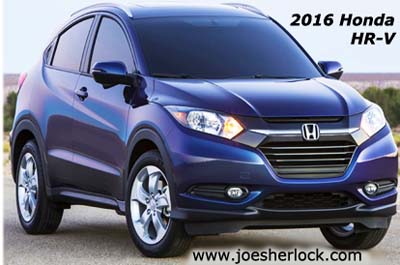 No more. Today, we are inundated with showroom choices, including the latest automotive aberration, the Cute Ute. These are bite-size SUVs based on subcompact car platforms. Led by the Subaru XV Crosstrek and Jeep Renegade, U.S. sales of these subcompact crossovers jumped 104% to nearly 43,000 units in August 2015, a year-over-year gain of 22,000 units. August marked the second consecutive month in which segment-wide sales more than doubled. No more. Today, we are inundated with showroom choices, including the latest automotive aberration, the Cute Ute. These are bite-size SUVs based on subcompact car platforms. Led by the Subaru XV Crosstrek and Jeep Renegade, U.S. sales of these subcompact crossovers jumped 104% to nearly 43,000 units in August 2015, a year-over-year gain of 22,000 units. August marked the second consecutive month in which segment-wide sales more than doubled.
Kia Soul, Nissan Juke, Jeep Renegade, Mazda CX-3, Chevy Trax, Buick Encore, Fiat 500X and the Honda Fit-based HR-V are just some of the offerings and are targeted at a "younger audience," as is everything these days. Usually, the Younger Audience can't afford the new offerings and they end up being purchased by empty nesters and other Older Audience members looking to downsize. That's what happened with the late, slightly-lamented Honda Element.
Dan Neil wrote, "It's all got to be so clever, doesn't it? Take the 2016 Honda HR-V, a subcompact crossover produced in Honda's new factory in Celaya, Mexico. Built on the same line as the Honda Fit and using much of the same componentry, the new HR-V is 9.1 inches longer than the Fit (on a 3.2-inch longer wheelbase), while about the same amount (10.3 inches) shorter than CR-V. The Fit and CR-V are hugely popular, globally, so it stands to reason something in the middle ought to be, too. Product spread, you know."
So, does all this marketing baloney make the 1946 Crosley CC Wagon the first cute ute? Probably not - it wasn't cute enough. (posted 10/13/15, permalink)
 Car Names: A car buddy of mine thinks that auto manufacturers are designating models alphanumerically because all the good car names are taken. I dunno. Car Names: A car buddy of mine thinks that auto manufacturers are designating models alphanumerically because all the good car names are taken. I dunno.
Plenty are still left: Bolus, Pale, Critter, Dry-Rot, Commode, Payback, Rectal, Walla-Walla, Lactose, Hat, Limpid, Sucks, Sarcophagus, Testicle, Soapscum, Cantaloupe, Dandruff, Yummi-Girl, Rancid, Thumb, Honeydew, Vermin, Stethoscope, Gingivitis, Thunderass, Vomit, Pill, Bloodsoaked, Dungheap, Sticky, Legume, Frightful, Slimemobile, Distress, Colitis, Hello Kitty, Phlegm, Eight-Track, Rastus, Slug, Turnip, Futon, Infertility, Lamprey, Squeegee, Flatulence, Insult, Eggplant, Turn-On, Hemorrhoid, Creature, Tumor, Urine, Knee, Nosebleed, Prude, Burrito, Hematoma and HootchieMama.
I bet some new Chinese car will utilize one or more of these model names. I think the HootchieMama 5000 would make a good name, especially if it's on a performance coupe with a huge engine.
Or ... there's the classic 1965 transporter from the B-52's 'Love Shack': "Hop in my Chrysler, it's as big as a Whale and it's about to set sail." The big blue convertible is claimed to seat about 20.
Maybe 40, if they're Chinese. (posted 10/9/15, permalink)
Auto Safety - 1958-Version: That was the year that engineer Walter C. Jerome of Massachusetts built a safety car called 'Sir Vival'. The articulated powertrain was said to "absorb collisions from any direction except dead-on" rear. The main body was derived from a '48 Hudson.
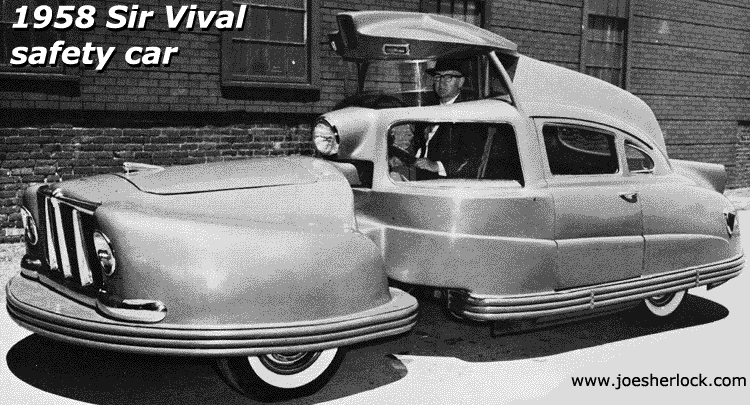
The driver sat in a raised central position. Instead of conventional windshield wipers, Jerome positioned built-in felt wipers on the inner and outer edges of the dome's frame. By rotating the dome, it was cleaned continuously. The car featured air-filled rubber bumpers and sliding side doors.
Jerome intended to produce 10-12 cars a year at a retail price of $10,000. This was not an inconsequential price tag given that a Series 62 Cadillac started at around $5,000 at that time. He was unable to get funding and the project never moved beyond prototype stage. Perhaps, if it had fins, a little style, more chrome and a three-tone paint job, he might have sold a few. (posted 9/21/15, permalink)
Answering The Question No One Has Asked: Borgward, an old and now-obscure German brand, is making a comeback with a Chinese-based SUV will hit the shores of Europe in 2017. A prototype will debut at the upcomng Frankfort Auto Show.
Borgward was once the second-largest automaker in Germany - the brainchild of Carl Fredrich Wilhelm Borgward. Carl was quite the inventor but, as a manufacturer, he was easily distracted, producing overlapping lines of cars as well as electric buses, helicopters and race cars.
The company found success in the 1920s, making a line of gasoline-powered delivery carts. The Borgward group eventually produced four brands - a pretty full range - of cars: Borgward, Hansa, Goliath and Lloyd. Parts interchangeability between various makes was almost nonexistent, increasing both tooling and production costs for the firm.
While Borgward pioneered technical innovations, such as air suspension and automatic transmission, it struggled to compete with larger, better-funded rivals such as Opel and Volkswagen. Herr Borgward's confusing management style, described as "pitting one assistant against another," didn't help things.
Borgwards arrived in the U.S. in the 1950s, represented by the typical chaotic independent importer structure of those days. Distribution and service were disorganized. Despite having some interesting offerings, the brand never made a dent in America.
Lloyd, a fairly ugly bare-bones marque, sold for less than a Volkswagen Beetle. It was cheaply-built and did not sell well in the U.S., although it apparently had a loyal fanbase of cheapskates in its Homeland. It has been said that Borgward lost money on every Lloyd it sold.
Best known of the export models was the Isabella, a fairly pleasant-looking sedan, which cost $2,500 - in the general price range of American mid-priced offerings - and was powered by a four-cylinder 66 horsepower engine. The father of one of my high school classmates, Jim, had a black two-door model. The doctor's car caught my attention because it was the only Borgward within a 10-mile area. Maybe more.
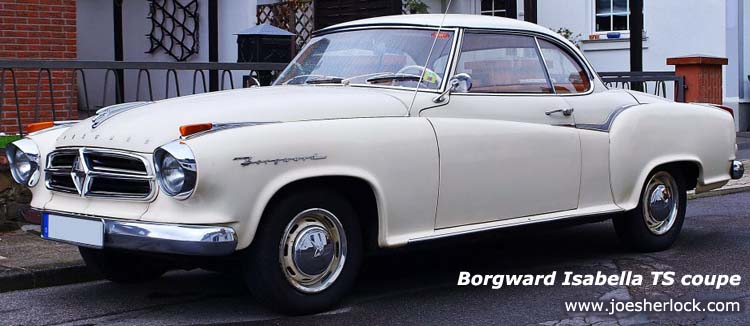
During my summer caddying days, I once hauled clubs for a man who owned an Borgward Isabella TS coupe, a decent-looking little car which reminded me of the Volkswagen Karmann Ghia. The TS cost $3,800 - quite a jump over the $2,600 K-G. But it did have a hopped-up 82 horsepower motor. The fellow I caddied for made a big deal about the TS, claiming that it was "the best-built car in Europe and cost more than a new high-end Cadillac." Yeah, right. I've often been puzzled about the kind of mental imbalance that compels an adult male to brag and lie just to impress a lowly, teenage golf caddy. Perhaps he was Baron Von Münchhausen in disguise.
These were the only encounters I've ever had with Borgwards. The firm suddenly declared bankruptcy in the early 1960s and was soon liquidated.
I doubt that the new one from the Middle Kingdom - apparently the Kia Sorento is its target market - will make it to American shores anytime soon. I'm not holding my breath. (posted 9/16/15, permalink)
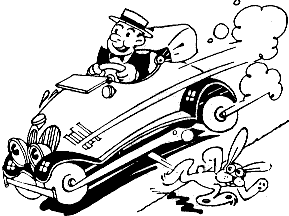 Blog Snob: Jack Baruth's younger brother, Bark M., took to the soapbox on The Truth About Cars recently to complain that there are too many car blogs. And that, when some bloggers attend press events, they dress poorly. Blog Snob: Jack Baruth's younger brother, Bark M., took to the soapbox on The Truth About Cars recently to complain that there are too many car blogs. And that, when some bloggers attend press events, they dress poorly.
As to his second complaint, don't get me started on proper dress and decorum. And hygiene. That's why I never fly coach anymore. By the way, I've not noticed working car journalists to be shining examples of sartorial splendor, especially in recent years. Except for the ones 'on camera'. End of discussion.
Now, back to the "too many car blogs" issue. My take is that Bark sounds annoyingly querulous. "Whine, whine. Oh, if only the rest of the world were as good/worthy as me." Oh, grow up. It's just an other example of Sherlock's Law: If you're in a random group of 14 or more people, you're going to run into a couple of ninnyhammers. Learn to deal with it.
Face facts: There is not much of the way of "journalism" in writing about cars anymore. At least, not since John R. Bond and L.J.K. Setright left the scene and took their objective Purity of Hearts with them. The New York Times Auto Section is basically entertainment fodder. And ads. I enjoy reading Dan Neil - a natty dresser, by the way - in the Wall Street Journal but there's not a lot of heavy-brain analysis to be found in his work. Lots of clever quips, though. That's how 'ol Dan got his-own-self a Pulitzer.
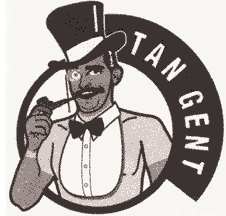 Allow me to digress and go off on a tangent - or, as Adam Carolla calls it, a Tan Gent. On a local level, The Columbian (a Vancouver, WA newspaper) used to have an on-staff writer, Tom Ryll, do car reviews. His articles were thought-provoking, engaging and often funny. Allow me to digress and go off on a tangent - or, as Adam Carolla calls it, a Tan Gent. On a local level, The Columbian (a Vancouver, WA newspaper) used to have an on-staff writer, Tom Ryll, do car reviews. His articles were thought-provoking, engaging and often funny.
A decade ago, the paper switched to a useless Friday automotive section, with the silly appellation, 'Cruise Control'. In between state-the-obvious fluff filler ('Don't Forget Your Tire Pressure', 'Winter's Coming! How's Your Antifreeze?', 'Has Your Car Insurance Expired?', etc.), the paper now features 'Auto Reviews' provided by Motor News Media Corp. a soulless flack house out of Iowa. MNM has never met a vehicle it didn't like. ("Inside the cabin, the driver enjoys a commanding view ...") These "road tests" appear to be pieced together from company press releases. Ken Chester, Jr., the author of most of this drivel, is president of Motor News Media.
Mr. Chester claims to personally review 120 cars each year. Since he must take some time off to go to automotive press briefings and newspaper conferences (to promote his column) as well as Christmas, vacations, etc., I would guess that he's got to do four a week just to meet his annual quota. What if it's raining? Or snowing? Or there's a tornado? (I mean, it's Iowa, for Pete's sake.) Well, I guess Ken can sit in the vehicle in his driveway and write about that "commanding view." Of the twister.
As an opinionated car enthusiast, I've often thought of contacting Ken and asking him how he sleeps at night. But, I'm afraid he'd counter with that famous answer from an old 'Simpsons' episode, "On a very large pile of money!"
Several years ago, Peter De Lorenzo exposed the Motor Trend 'Car of the Year' scam where car companies basically 'purchase' the award. Plying the highways and byways of auto journalism, Diogenes' trek would soon be full of frustration. He'd probably soon be popping Prozak and gleefully testing a Fiat 500X on the streets of Sinope.
Having a plethora of blogs gives readers choices. And, as Martha Stewart often said after a satisfying prison meal, "It's a good thing." Readers can pick and choose what to read. And these blogs are free. You don't have to pay for them at the magazine rack or subsidize them with some kind of NPR tax.
I'm one of those "little car blog guys," although I get fairly decent traffic - 4-500,000 hits/month. But I rarely get invites to manufacturer car events because I don't try to curry favor with them. I write what I think and I choose subjects which interest me. I also haven't accepted bribes, although - to be honest - I haven't been offered any really good ones. So, that segment of my integrity is ... ummmmm ... untested.
If you enjoy my writings, please come back to The View Through The Windshield regularly - I update it 2-4 times each week. If not, move on to a blog which better suits you and your needs. I'll respect your taste and you won't hurt my feelings.
Finally, I must note that it's ironic that The Truth About Cars should be bitching about other blogs given the decline in overall TTAC content quality in recent months. Fix your own house, boys. (posted 9/7/15, permalink)
Rare Sighting: My wife took some cool photos of an unusual hot rod last week in Battle Ground Village. It's a 1926 Packard Boattail made by custom car maker Peter Portugal of Eureka, California.
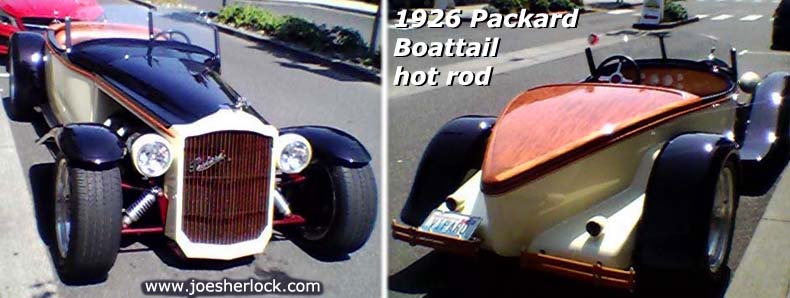
Portugal started with a cowl from a '26 Packard, and from there built the speedster. He put a boat tail on his speedster and enhanced it with a redwood deck lid. Portugal said that he "built the speedster to look old, but upgraded the steering and tires to make the car more drivable."
"From there, I thought I might as well make a hot rod, so I put a modern engine in it. It has modern headlights, taillights, transmission and a huge engine - a 2005 10-cylinder 500-horsepower Viper. It's really fast." Awesome machine, eh? (posted 8/26/15, permalink)
Arriving In Style: Ronnie Schreiber is a fan of the dual-cowl bodystyle of the 1920s and '30s. He noted that "the phaeton roof line is one of the masterpieces of automotive styling. There is a reason why Dean Jeffries made the Monkeemobile a phaeton, beyond the need for seating for all four band members in the back. The long roof (one reason why enthusiasts are attracted to station wagons) and the way it peaks in the back and then slopes towards the front of the car simply looks good."
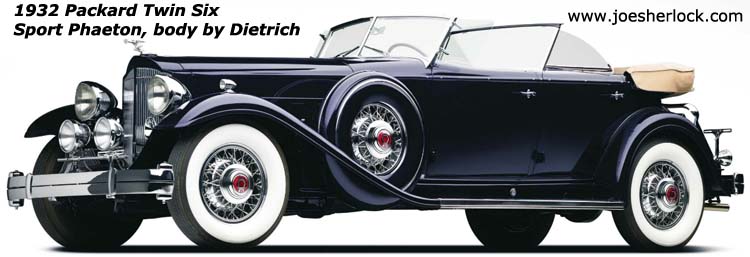
I agree that, on a long open car, it's nice for the passengers to have their own protective windshield. But I'm not sure that I'd put the words "masterpieces of automotive styling" and "Monkeymobile" in the same paragraph. Oh, well. Chacun à son goût.
Ronnie continued, "Then there's the dual cowl aspect. Though they are not exactly limousines, they're functionally equivalent, the owner rides in back, so there is that side of being able to show off your wealth by having a chauffeur. Also, the second cowl gives it the look of a parade car, whether or not the roof is up or down. It's easy to visualize Queen Elizabeth doing her queenly wave from the back seat."
Chrysler made three custom-built Parade phaetons in 1952 and updated the styling in 1956.
I'm more of a classic town car fan myself, where the chauffeur is exposed to the elements while the occupants of the closed portion keep warm and sip Moët & Chandon champagne while munching on crudités or caviar. It shows the lesser people who's boss.
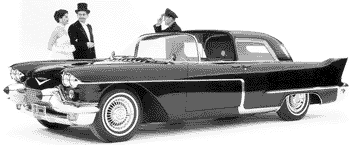 Cadillac exhibited a town car concept in 1956. Officially known as the Eldorado Brougham Town Car, this opulent exercise was part of the 1956 GM Motorama. Cadillac exhibited a town car concept in 1956. Officially known as the Eldorado Brougham Town Car, this opulent exercise was part of the 1956 GM Motorama.
The styling foretold the look of the $13,000 Cadillac Eldorado Brougham four-door hardtop of 1957-58. The passenger compartment of the Town Car contained "such items as a radio-telephone combination, air-conditioning equipment, a women's vanity compartment, cigar humidor and thermos bottle."
Nothing says luxury better than a thermos bottle. (Remember Steve Martin in 'The Jerk'?)
In 1993, I penned a modern town car based on - what else?! - the Lincoln Town Car.

The Lincoln V12 engine idea - a proper powerplant for a flaghip Lincoln - appeared in the 1996 Lincoln Sentinel running concept. It was rumored to be two Taurus V-6 motors joined together. And, if Lincoln ever returned to Designer Edition model variants, this Town Car towncar would make the perfect platform for a Donald Trump Edition. (posted 8/24/15, permalink)
Monterey Week 2015: Last week's annual car fest offered the usual mix of spectacular and interesting vehicles on display as well as some wild auto auction results. Monterey Week includes road rallies, races, auctions, displays, seminars, exhibitions, parties and new model introductions by auto manufacturers. And traffic jams, as people try to attend every event and cram in every activity.
It can be exhausting. I know. I traveled there in 1996, when things were far less hectic with fewer people in attendance and not as many venues. (And yes, I still have my Pebble Beach Miracle Hat.) In my lifetime, I've been to hundreds of automotive events and nothing compared to Monterey. I recommend that every car enthusiast do Monterey Week at least once in his/her lifetime. It's Pamplona for those who are interested in powerful, snorting creatures of a mechanical nature. With wheels rather than hooves.
The area's convention bureau expects more than 85,000 visitors will drop more than $50 million on hotel rooms, restaurants and bar tabs this year. The locals whine but they like the trickle-down effect of all that money, so they smile, make nice and mutter under their breath when no one is listening.
At Sunday's Pebble Beach Concours - the pinnacle and conclusion of the Monterey Week experience, Best of Show was awarded to a 1924 Isotta Fraschini Tipo 8A sport cabriolet, owned by Jim Patterson, from Louisville, Kentucky.
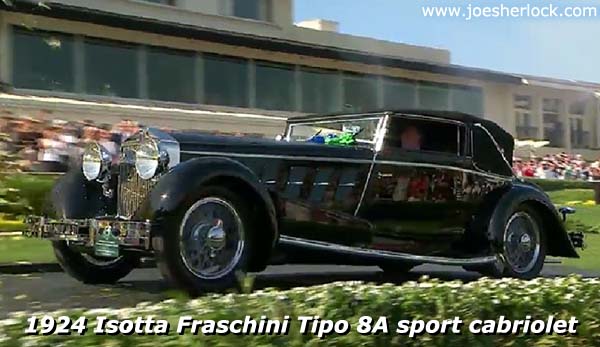
Then there were the auctions.
RM Sothebys gaveled down several high-dollar autos last week, including ... (more >>>)
Mint-Condition, Authentic Jerks: Recently, Ronnie Schreiber wrote about a wonderfully restored 1938 Packard Super Eight 1605 convertible sedan, shown at this year's Detroit-area Concours of America.
The owner's grandson was talking about the Packard Blue color "just as another Packard enthusiast was walking by. "That's not Packard blue, it's too purple," said the passerby. It almost got heated."
Ronnie went on to relate details of this car's Packard Blue and the science behind paint selection. This '38 Packard may actually have the most accurate rendition of the color than any other Packard.
Those who show their cars are often subjected to insults and jeers from jerks. Most of these people don't have a car to show. Often they are the owners of a deplorable, rusting automotive prolemobile under a tarp somewhere.
Ronnie later said to the grandson, "Boy, he went all NCRS on you, didn't he?" I soon learned that NCRS stood for "National Corvette Restoration Society, perhaps the world's most anal retentive group of car guys. NCRS certifies restored Vettes as being right - or wrong - as the case may be. When I say 'going NCRS on it' to people who collect cars, they smile knowingly.
It's one thing if a judge at a show mentions a flaw or inaccuracy. It's another for someone just attending a show to rag on an exhibitor who's spent time and a non-trivial amount of money to share his or her car with the public."
Boy, did this article hit home with me. My memory drifted back to 1983 when I entered my old Volkswagen Beetle in the Oregon State University Concours d'Elegance. My freshly-restored Bug won First in Class. (The class was 'imported cars with original POE price of less than $3,000'.)
|
|
| My 1967 Beetle on display at the 1983 OSU Concours, including a selection of miniature VWs in a Plexiglas display case. |
As I was waiting in line with my car to receive a trophy, a glum guy came up to me and said, "Your car's not so great. I've got a Beetle at home that's much better than yours." I replied, "Too bad you didn't participate in this show. But I'll be back next year. Why don't you bring your car and compete with me for first place?" He turned and slinked away without a word.
I returned with my Beetle the following year. Mr. Grim-face Jerk and his (alleged) Volkswagen were nowhere to be found. (posted 8/12/15, permalink)
High-Revving College Days: There's an interesting back story about the styling of the Chrysler Turbine Car posted at TTAC. Chrysler produced a total of 55 vehicles and the bodies were made by Ghia in Turin, Italy.
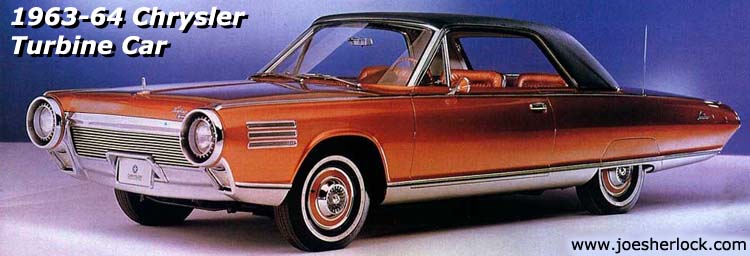
Early on, Chrysler Turbine Cars were driven to and exhibited at various engineering schools, probably for general promotion and subtle recruitment for future engineers.
A Chrysler Turbine car was shown at Villanova University when I was an engineering student there. I can't remember the exact time but I think it was during the Spring of 1964. The sleek car was displayed in the parking area behind Tolentine Hall which was then the Engineering Building. The young man demonstrating the vehicle placed a nickel on edge on the turbine engine and revved up the motor. The coin never fell over - an impressive accomplishment.
I remember the Turbine being a cool-looking car, better-looking in person than in photographs. Later in my life, I saw Chrysler Turbine cars on display at other automobile venues, including the Henry Ford Museum in Dearborn, MI. (posted 8/6/15, permalink)
Zapping Your Lungs: A new study reveals that electric cars have an overall impact on pollution that may be worse than gas-guzzling vehicles.
The study looked at U.S. vehicle emissions on a county-level to map where gas cars and electric vehicles cause the most damage to the environment.
It found that, in the eastern U.S., the impact of charging up EVs overnight does more harm to the environment than going to a gas station.
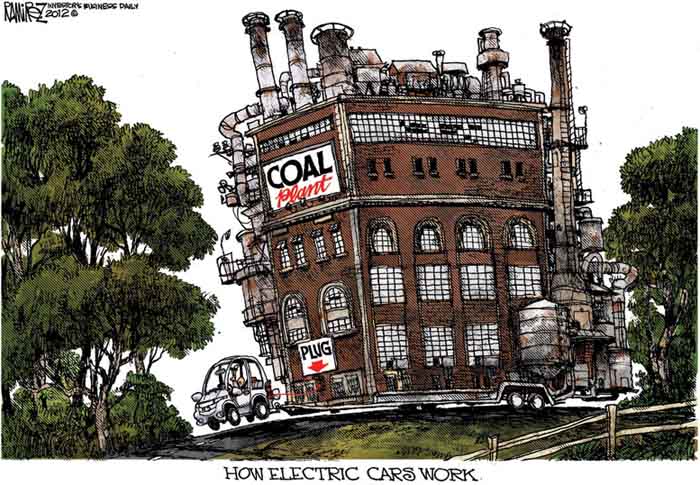
Electric cars were marginal in 1911, when everyone realized their limitations. The technology has not improved much since then and, because they are subject to the laws of materials science, electric cars are inefficient and, essentially, coal fired in most cases. If dirty 'ol anthracite is the primary source fuel for an electric power grid, then - de facto - electric cars are not clean vehicles. Regardless of what self-styled environmentalist friends proclaim.
Electric vehicles don't make much sense in any case. Such automotive offerings will have a very limited market as long as they take many hours to 'fill up', are essentially unusable beyond a 40 to 50 mile radius from your home, can leave you 'stranded' on overnight trips and are not competitively priced compared with gasoline and hybrid vehicles.
Then there's the questionable battery life and high cost of replacement. EVs are not the holy grail of automobiles. They weren't 100 years ago either. Just ask owners of the Baker Electric car. (posted 7/29/15, permalink)
Chopped & Channeled: If suicide doors were such a good idea, why not guillotine doors?
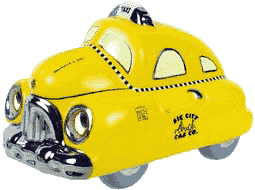 What New York Really Needs ... is a 'Taxi of Yesterday'. The unattractive Nissan NV 200, once referred to as the Taxi of Tomorrow, has been crowned the new official taxi for NYC by the New York City Taxi and Limousine Commission. What New York Really Needs ... is a 'Taxi of Yesterday'. The unattractive Nissan NV 200, once referred to as the Taxi of Tomorrow, has been crowned the new official taxi for NYC by the New York City Taxi and Limousine Commission.
The Nissan is dull and uninspired and will never become iconic like the late, great Checkers of yore. Where's that New York City style, edginess and audacity?
New York deserves something more fun: cartoon cabs, looking like the Toontown yellow taxicab or Speedy Gonzales' Tijuana Taxi.
Ones that will generate tire-screeching noises with the slightest lateral move, have horns that can go 'Oooooga' and make sounds like a giant whoopee cushion whenever they hit a pothole. And have big eyes for headlights.
And broadcast random, side-of the mouth, wiseguy comments in a '40s Brooklyn accent, like "Hey toots, ya look hot." (posted 7/13/15, permalink)
Another Sign Of End Times? Lotus plans to introduce an SUV model.
What's next? Lightweight bulldozers? Streamlined agricultural equipment? A stylish Ditch Witch?
When the four horsemen of the apocalypse finally show up, I believe they'll be wearing those 'Buy One - Get Three More Free' suits from Joseph A. Bank. (posted 7/13/15, permalink)
Whither Scion? Scion VP Doug Murtha recently told WardsAuto that as of the end of this year, the quirky ScionxB will be gone. "It will have lived just one year longer than the Scion xD, which was updated for the 2014 model year and at one point had been expected to live until the end of this year." The odd iQ has also been discontinued.
Rolling boxes seemed to be a short-lived fad whose time in the sun is over. The Honda Element (which looked like it was styled by Rubbermaid) and weird-looking Nissan Cube are gone. The Kia Soul is the last of the proud containermobiles and, six years into its run here, it is doing better than ever, 2014 being a record year for the Soul. Inexplicably, it is perceived as offbeat but cool.
Scion's long-term goal was to appeal to Generation Y consumers. The first Scions appeared in the 2003 model year. The best selling year of the marque since introduction was 2006 with 173,000 vehicles sold. But sales slid since then to 57,961 vehicles in 2009. Sales of the Scion brand were down to a low of 45,678 in 2010, compared to over 170,000 in model year 2006.
Scion sold 3,838 cars in June 2015. Scion's year-to-date sales are down almost 19%. Meanwhile, Toyota sold 179,953 vehicles in June 2015 - 90,952 cars and 89,001 trucks/SUVs. Its luxury brand Lexus sold almost seven times as many vehicles as Scion. Mini, another specialty brand, sold 6,174 units in June. Scion, despite a broader product line, barely outsold Fiat (3,173 vehicles) last month.
AutoExtremist Peter De Lorenzo suggested, "Scion: Somewhat successful, at least initially, this "clean sheet" youth-targeted brand – even though most early adopter buyers were over the age of 45 – is over. Just take it out back and put it out of its misery because this just in: nobody cares. The AE Brand Image Meter? Icy dead. As in Dawn of a New Ice Age."
Scions seem to be evolving toward becoming badge-engineered Toyotas. Look how well that worked out for Plymouth and Mercury. (posted 7/9/15, permalink)
Branding - The Battle For The Car Buyer's Mind: In 1980, marketing gurus Al Ries and Jack Trout wrote 'Positioning: The Battle for Your Mind'.
Positioning is also defined as the way by which the marketers attempt to create a distinct impression or perception in the customer's mind; specifically, "the place a product, brand, or group of products occupies in consumers' minds relative to competing offerings."
Perception is reality - you are whatever other people think you are. Branding is part of the positioning/perception process. The principles outlined in Ries & Trout's various books are applicable to all types of products and companies in all industries ... (more >>>)
Custom Gasoline: Formerly known as Sun Oil Co., the Philadelphia-based refiner was best known for its Sunoco 'custom blending pumps', an innovation that, beginning in 1958, allowed customers of Sunoco service stations to choose from several octane grades through a single gas pump.
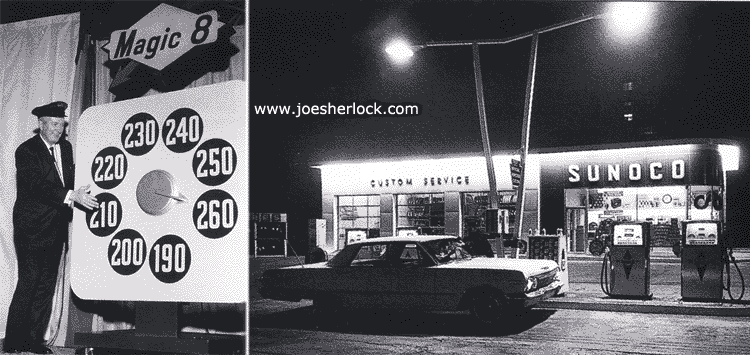
Sunoco stations offered five to eight octane grades of 'Custom Blended' gasolines from its Dial-A-Grade pumps ranging from cheapie Sunoco 190 to super-premium, 102 octane Sunoco 260.
Sunoco 260 was very popular with owners of '60s muscle cars.
When I owned my 1963 Volkswagen during my college years, I would often fill up with Sunoco. Regardless of the blend I selected, the car cost 1¢ per mile in gas consumption. Low-octane Sunoco 190 was cheaper but produced poorer mileage. 260 was expensive but resulted in improved mpg. (posted 6/15/15, permalink)
Makin' Mercs: Fifty years ago, Mercury was a hot-seller. In 1965, it ranked #8 in sales, ahead of Rambler, Chrysler, Cadillac, Lincoln and Studebaker. The full-size Monterey, Montclair and Park Lane models rode on a 123-inch wheelbase. Breezeway windows (an opening rear window with reverse slant glass, as seen on the 1958-60 Lincoln Continental models) were an option on four-door models.
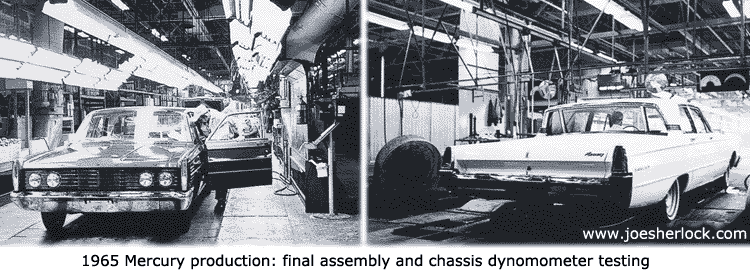
1965 Mercury prices ranged from $2,700 to $3,500 depending on the model and body style. V8 engines ranged from 250 to 400 horsepower, depending on the option box checked. (posted 6/11/15, permalink)
You're Never Too Old: Occasionally, friends who are not car enthusiasts ask how long I'm going to keep driving my old Plymouth coupe. I've not given the matter much thought. I suppose that I plan to drive it for as long as I am able to drive.
A few weeks ago, Dennis Gage of 'My Classic Car' spoke with 104 year-old Margaret Dunning about her 1930 Packard which she drives regularly.
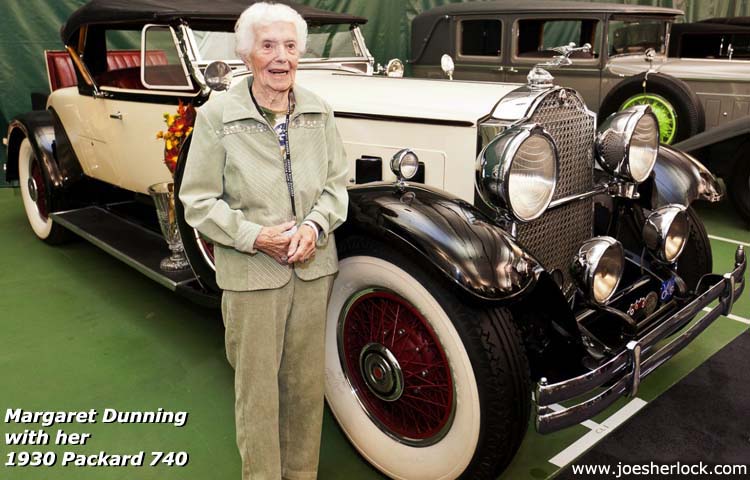
The interview was held at a car show in Kentucky. The 'Belle of the Concours', as she is known, was exhibiting her 1930 Packard Straight Eight 740 convertible.
She's been driving since she was 8 years old, and officially received her license at 12, after her father died. "I drive it every month because a car should be kept active," said the Plymouth, MI woman, who showed her Packard in 2012 at the Pebble Beach Concours D'Elegance. She quipped, "It's got a four on the floor so it has plenty of power."
She's a car collector, and the Packard, glistening beneath 22 coats of hand-rubbed lacquer, is one of six vehicles that she owns. Until a few years ago, she did her own car maintenance, including crawling underneath to change the oil. Margaret purchased the car in 1949.
Sadly, Margaret died on May 17, 2015 from injuries sustained from an accidental fall during a visit to Santa Barbara, CA. During her California trip, she had met with fellow car enthusiast Jay Leno. Ms. Dunning was also a well-known philanthropist, who helped build and later expand the Plymouth Historical Museum and was involved in countless community projects during nine decades in Plymouth, MI.
Requiescat In Pace. (posted 5/22/15, permalink)
Citroën DS 19: When unveiled in 1955, the quirky French sedan seemed like something from the far future, at least to my 12 year-old brain. I was fascinated by the photos and description in magazines such as Motor Trend and Motor Life.
 Dan Neil confirmed that it look like nothing else on the road back in the day, noting that "should you park one next to a '55 Chevy Bel Air, which then appears to have been built by cave-dwellers. The DS was a front-mid-engine, front-wheel-drive car with rear wheels closer together than at the front, allowing its sleek, tapering bobtail. The rears are enclosed in prim fender spats and, above, the remarkable panoramic greenhouse and fiberglass roof, canted like a beret. Did we mention it was French?" Dan Neil confirmed that it look like nothing else on the road back in the day, noting that "should you park one next to a '55 Chevy Bel Air, which then appears to have been built by cave-dwellers. The DS was a front-mid-engine, front-wheel-drive car with rear wheels closer together than at the front, allowing its sleek, tapering bobtail. The rears are enclosed in prim fender spats and, above, the remarkable panoramic greenhouse and fiberglass roof, canted like a beret. Did we mention it was French?"
Neil wrote, "Sixty years after its introduction at the Paris Auto Show, the futuristic, perfectly Gallic Citroën DS 19 (D series from 1955-75) retains the ability to wow, an atom bomb of style from a time when atom bombs were kind of cool. The DS was the most technically gifted automobile of its time and the most quintessentially modern, in that it scorned all that was familiar in prewar design - big, exposed wheels, low roofs, strong shoulders and commanding chrome grilles - in favor of something utterly new, at least outside the realm of pulp science fiction."
Some of the car's features included a distinctive one-spoke steering wheel; the trendsetting multidirectional air vents, directed by little wands with plastic knobs; the turn signals located in chrome nacelles fixed to the roof for better visibility. "The DS's high-pressure plumbing could also raise the car's body to traverse poor roads, high enough even that owners could change a tire without using a jack. Charles de Gaulle credited the DS's unique suspension with helping him escape a 1962 assassination attempt even after the Citroën's tires were shot out."
Rear turn signals were mounted in the roof - predating the Mercury XM Turnpike Cruiser dream car by more than a year.
How does it drive? Dan reported, "I slot the column gearshift to first and the big Citroën embarks on a strange, oily sea. The little four-banger doesn't have much, about 70 horsepower, but it gives willingly. The rack and pinion steering is firm and reasonably keen for a vintage car. The Citroën's body rolls with nautical dignity, well damped, while floating above the busily pumping wheels. Obviously, the DS was designed to conquer the vast straight-aheads and is less composed with a lot of steering dialed in. But once at highway speeds, the Citroën rolls out the magic carpet.
The seats are royal, the ride sublime. Few modern cars, maybe none, are as splendidly comfortable as the DS."
Citroën sold nearly 1.5 million of the revolutionary D-series during the model's 20-year production run. Not many came to the U.S.
Traveling in a herd of American cars on the freeway, the Citroën DS-19 has the same visual effect as a guy with a shaved head and goatee in a crowd: looking like something from another planet. Or an alternate universe. Or, if dressed in a silver lame' jumpsuit, the future.
Neil called the DS 19 as the most beautiful car in the world. So did Classic & Sportscar magazine. Meh. Chacun à son goût. (posted 5/18/15, permalink)
Graduation Gift On Wheels: Last Saturday, we gave our grandson his high school graduation gift - a 2013 Mazda3 i Sport - lightly used with only 17,000 miles on the odometer. He had no idea that this gift was in the works, so he was shocked and pleasantly surprised.
|
|
|
Connor's first reaction to his new car
|
Connor officially starts college in September but he will be taking summer classes and will need a means of transport. Hence the early gift.
My wife and I did a lot of research before selecting a Mazda3. The primary reasons we chose it were:
1. It's a durable and reliable car, according to Consumer Reports and other sources.
2. This vehicle will hold up for the next 5-7 years, until he completes school (he may go to grad school after college) and has a year or two invested in a paying job in the engineering field. Then he can buy something else.
3. Mazda3s are cool cars and, with a little care, I suspect this one will still look reasonably contemporary in 2020.
4. Used Mazda3s are a good value proposition; they depreciate faster than Honda Civics or Toyota Corollas during the first few years. Therefore, you can get more car for your used car dollar.
We considered other cars: Kia Rio (too small, too dull), Kia Forte Koup (couldn't find any good ones in the Portland area), Subaru Impreza (like Civic and Corolla, too expensive for what ya get). We avoided Mini-Coopers - while they certainly have the right 'cool' factor, they are notoriously trouble-prone and there's only one dealer in the entire state of Oregon, an 85 mile trek from where our grandson lives. The Chevy Cruise can be had for less than the Mazda but it was given a bad rating - solid black dots - from Consumer Reports. As did the too-small Chevrolet Sonic.
After checking what was available using cargurus.com, we visited three dealerships before we purchased this car In two cases, the vehicle was not as advertised and the salesmen's attitudes ranged from distracted to confused to indifferent. We finally made our purchase at Sunset Audi in Beaverton, OR. We had a really good buying experience; if you're interested in a used car, I recommend that you contact Mike Harvey. He was honest and professional in his dealings with us.
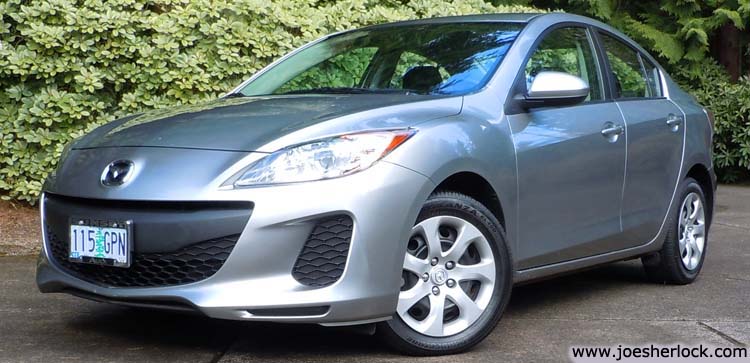
The Mazda3 i Sport lives up to its sporty name. It handles well in the turns and is quite fast when you put your foot down. The seats are too firm for my posterior as is the ride. But, given that I'm arthritic (and used to driving a plush luxury car) and am 54 years older than my grandson, my opinion doesn't count. He likes the ride, handling and seat comfort just fine.
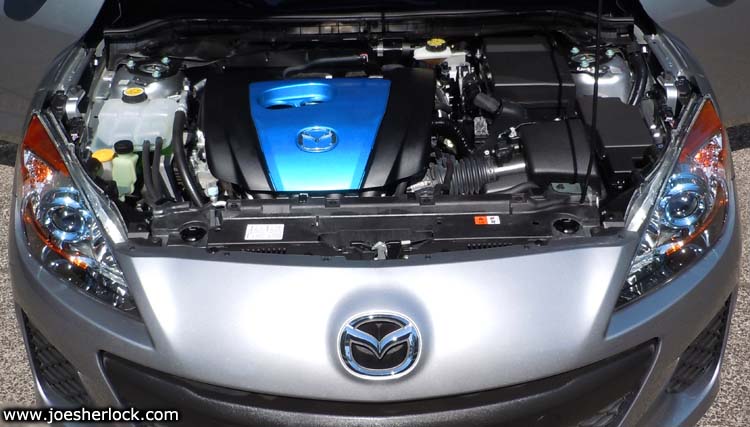
The Mazda3 i Sports' 155 horsepower, 2.0-liter Skyactiv engine coupled to a 6-speed automatic transmission gets it from a standing start to 60 mph in a reported 7.9 seconds. The car feels peppy but is also a miser; it has EPA fuel economy ratings of 28 mpg city/40 mpg highway. The dashboard trip meter reported 31.7 mpg based on the last 800 miles.
The car has a charcoal and gray fabric interior. The exterior dimensions (104-inch wheelbase; 181-inch overall length) are almost identical to the family's unloved 1980 Oldsmobile Omega, which eventually became our daughter's college car. Yet the interior of the Olds seemed larger, especially in the back seat area. And the exterior looked larger than the Mazda3.
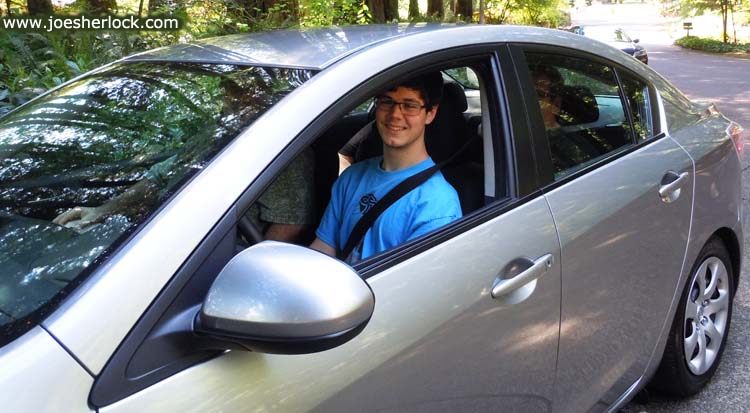
The coolest feature in this Mazda3 is that, when you put the key in the ignition and turn it, the dashboard info display greets you with a digital 'Hello.' When you remove the key from the ignition, the display reads, 'Goodbye'. Awesomely cool.
You'll find lots more photos posted here.
There is precedent for the giving of college cars within our family. My grandmother gave her son Ed a '41 Chrysler Saratoga when he entered college in 1944. She also bought me - her first-born grandson - a red 1963 VW Beetle sedan when I was a sophomore in college.
In 1975, I presented my brother with Underdog, a black 1963 Beetle which my dad had purchased new and later gave to me. We gave our son a family hand-me-down 1967 Volkswagen Beetle in 1984 when he was in high school. He used it for college, too and, when he was near graduation in 1989, we gave him a red 1989 Ford Probe.
We presented our daughter with a family hand-me-down 1980 Oldsmobile Omega in early 1987 when she was in high school. She took it to college and when it was on its last legs in February 1993, we traded it in for her early graduation gift, a purple 1993 Saturn SC coupe.
And the beat goes on. (posted 5/12/15, permalink)
Ancient Wanderer: Dan Neil recently drove a replica of Buckminster Fuller's 1933 3-wheeled Dymaxion automobile.
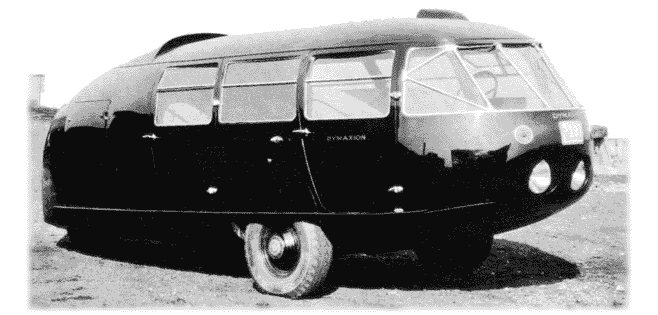
It was a frightening experience for Dan because "the Dymaxion's single rear wheel, mounted on a girder-like swing-arm enclosed in the aluminum-skinned gondola, tends to walk downhill, away from the crown of the road. When the driver corrects or the grade changes, the suspension and steering inputs tend to induce a springy oscillation. The faster you go, the more it feels like you're never going to catch it."
"At no point in my test drive on the glass-smooth Natchez Trace outside of Nashville did I exceed 40 mph. And several times I was seized with terror when the 20-foot vehicle developed uneasy, oscillating swivels, with the tail wanting to wobble like a shopping cart's bad wheel. You drive with fingertips, breathless, very gently, because if you don't … OOPS, WHAM! Over you go."
The original Dymaxion seated 11 people. And had a bad reputation. "It crashed at the 1933 Chicago World's Fair, killing the test driver and injuring two passengers in an accident that was splashed across front pages, scaring off investors. Later it was sold to Gulf Oil and was burned to the axles in a refueling incident."
Sometimes, futuristic dream cars turn out to be nightmares. (posted 5/4/15, permalink)
1941 Milestone: In 1941, the five-millionth Dodge was built - a four-door sedan.
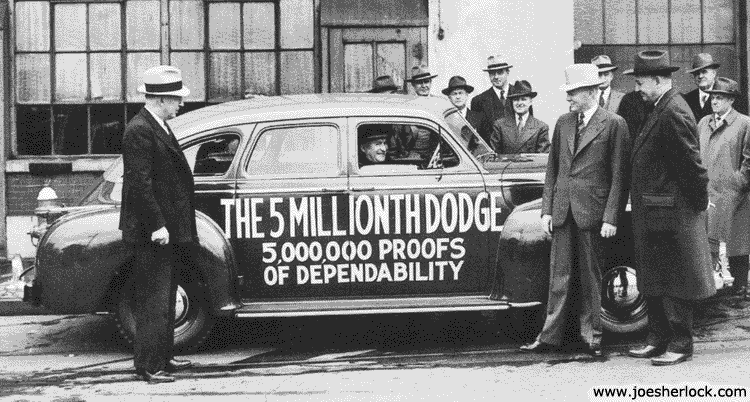
It was a production milestone that took the company 27 years to achieve. 1941 was the first year that Fluid Drive transmissions were available on Dodges as a $25 option.
A basic '41 Dodge De Luxe business coupe could be had for as little as $862. All 1941 Dodges were powered by a flathead six-cylinder engine, making 91 horsepower. Dodge produced 237,002 cars in the 1941 model year, putting it at 7th place in sales, behind Chevrolet, Ford, Plymouth, Buick, Pontiac and Oldsmobile. (posted 4/27/15, permalink)
 How Do You Say 'Big Shakeup' In German? The very aggressive and authoritative (but aren't most Germans authoritative?) Ferdinand Piëch, 78-year-old grandson of Ferdinand Porsche, has been forced out of his Chairman position at Volkswagen AG. Piëch's current wife, Ursula, also resigned her positions within the company. How Do You Say 'Big Shakeup' In German? The very aggressive and authoritative (but aren't most Germans authoritative?) Ferdinand Piëch, 78-year-old grandson of Ferdinand Porsche, has been forced out of his Chairman position at Volkswagen AG. Piëch's current wife, Ursula, also resigned her positions within the company.
Piëch recently sought to oust Martin Winterkorn, a onetime protégé, as Volkswagen's chief executive. But the move backfired after Mr. Winterkorn refused to go and other members of the supervisory board rallied behind him.
Never short on hubris, Piëch had some great ideas but some losers as well, notably the attempt to move Volkswagen into the luxury market with the ill-fated Phaeton model. Piëch also failed to develop exciting and successful affordable vehicles in key segments and was unable to resuscitate the large U.S. market; the VW assembly plant in Chattanooga, TN is greatly underutilized. VW's efforts in China are faltering as competition becomes more intense and VW Group's Spanish SEAT brand remains on death watch.
During the past twelve years, the company's overall return on sales has dropped by more than half. Nevertheless, Piëch is credited with rescuing Volkswagen from near bankruptcy after he took over as chief executive in 1993. He was an engineer both by training and by nature who viewed technical excellence as the key to success in the car industry.
Piëch's prolific firing of subordinates throughout his career has been legendary in automotive circles. According to Piëch, he fired any subordinate who "makes the same mistake twice." I bet he was rough on long lunch breaks, sick leaves and comp days, too.
Peter De Lorenzo wrote, "A scion of the Porsche family, Piech conducted himself unimpeded, knowing full well that he was basically untouchable ... Piech used to be considered a mad genius, but now it's looking more and more like he's just mad."
Ferdinand Piëch is fabulously wealthy, so you won't see him in line at a soup kitchen or food bank anytime soon. He and his wife drive a pair of Bugatti Veyrons. It's rumored that every time someone says "Porsche," they have to pay Piëch a royalty fee of one Euro. We Americans avoid this by referring to the little German sports car as a "Porch." But while Herr Piëch's wealth is preserved, his ego is probably badly dented - like a semi-wrecked Porch. (posted 4/27/15, permalink)
Trunk Girl: I've written about the 1940 Pontiac Ghost Car before. I saw the car in person at Pebble Beach in 1996. Recently, I came across another photo of this remarkable vehicle:
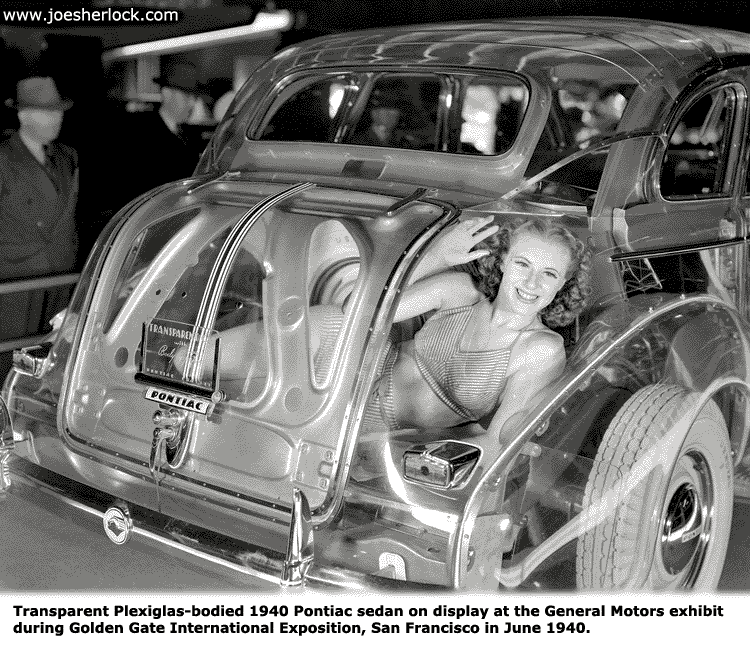
It is a bit unsettling when you realize that the cutie in the trunk is probably now in her 90s. (posted 4/9/15, permalink)
New York Auto Show: The online auto news sites have been busy covering new vehicles to be displayed at this year's show. Here are observations on selected 2016 models:
• 2016 Cadillac CT6: The long awaited Cadillac flagship debuted in NYC. Unfortunately, the base engine is a four cylinder, hardly a threat to its intended rivals such as the S-Class, 7-Series and LS 460. The new Caddy is FWD based but six-cylinder models will get AWD. The most-powerful engine available will be a 400 hp, 180 cubic inch, twin-turbo V6.
The CT6 rides on a 122.4-inch wheelbase and is 204 inches long. I found the styling not very impressive; it looked like a stretched CTS with an XTS bustle back.
So much for 'Dare Greatly'.
• 2016 Chevrolet Malibu: It's all-new with the coupe-like (sleek but headroom-killing) roofline. It looked swoopy in profile but blocky and disjointed in front. Last year, Chevy sold 188,519 Malibus (many of them finding homes in rental fleets), a 6% decline from 2013, and fewer than half the number of Toyota Camrys and Honda Accords sold.
I don't think this is the savior that Chevy is looking for.
• The Honda Civic Concept, reportedly a thinly-disguised version of the 2016 Civic coupe looks pretty cool.
• Jaguar XF: This lighter, fully-redesigned mid-size luxury sedan needs more chrome and maybe a V8. The rear seat still looks tight legroom-wise, which was a problem with the original Lincoln LS-based car.
The interior looks too plain-vanilla for a Jaguar.
• Kia Optima: A year after the all-new Hyundai Sonata, its Kia sibling made its debut in New York. It is still a nice-looking sedan to my eyes, although I like the last generation model more.
• Land Rover introduced the Range Rover Autograph Edition, priced at $200,000. For that kind of money, I think God's autograph should be on the hood. A Rover spokesman said that the New York area is the biggest geographical market for the brand.
• Lexus RX: This luxury crossover is Lexus' best-selling model, representing about one-third of the brands overall sales. It has been given an all-new design. The spindle grille is even more prominent and the vehicle has been given sharp, Darth Vaderesque "character lines" (ie: creases). I think it's incredibly hideous from every angle but, Lucky fro Lexus, I'm not the target market.
• McLaren 570S Coupe: This 570 horsepower rival to the Porsche 911 Turbo weighs just under 2,900 pounds and is priced at $180,000, which calculates out to just over $62/lb - cheaper than gold, silver, caviar or many of Whole Foods deli meats.
• Mercedes-Benz GLE-Class is a renamed, re-styled Mercedes ML with a grille which, at least in the photographs, reminds me of a 10 year-old Dodge Charger.
• Nissan Maxima: After being briefly revealed in a 2015 Super Bowl ad, this is the first public appearance for the new Maxima. It has 300 horsepower and a starting price of $32,500. The styling isn't wonderful but better than Nissan typically offers these days. The front end, while Samurai fierce-looking, is far better than what's being put on the front of Lexus vehicles these days.
• Scion iA: Scion's new four-door sedan is really a rebadged Mazda2. The car has a very sad and downtrodden face; it's almost as if it expects to fail epically.
Prices for this beast start at $16,000. Scion sales are down 17% year-to-date. This new model won't help. (posted 4/5/15, permalink)
Alternate Designs:
Make It, Ship It, Sell It:
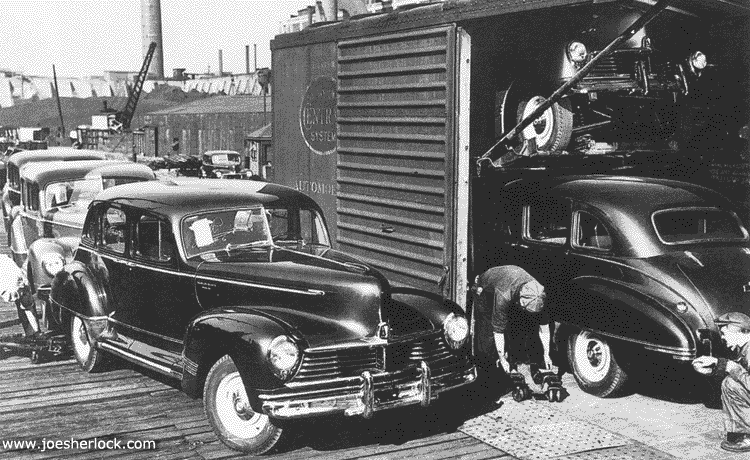
The first shipment of new 1946 Hudsons left the Detroit plant in September, 1945 and were loaded into New York Central Railroad boxcars. (posted 2/18/15, permalink)
Master Of The Road: The Roadmaster was once the top-of-the-line Buick model. Roadmasters produced between 1936 and 1958 were built on Buick's longest non-limousine wheelbase and shared their basic structure with entry-level Cadillac and, after 1940, senior Oldsmobiles. Between 1946 and 1957 the Roadmaster served as Buick's flagship. The name was resurrected for the 1991 through 1996 model years, when it was once again the marque's largest vehicle.

For the 1953 model year, Buick had something to crow about - a new overhead-valve, "nailhead" V8 engine replacing the ancient straight-eight which had been used since 1937. It arrived just in time to celebrate Buick's Golden Anniversary. Helping to bring in that new year was the semi-custom, expensive and striking Skylark convertible, as well as the availability of power steering on Buick models. A 12-volt battery system was now standard to help crank the big, new high-compression V8 motor.
Entry-level Buick Specials still had the old L-head straight eight engine, which produced 125 horsepower. All other Buicks got the new ohv V8; the Roadmaster version produced 188 horsepower. In 1953, Roadmaster was the only model with four portholes in the side of each front fender; Buick Referred to them as VentiPorts.
The 1953 Roadmaster Riviera sedans were big cars ... (more >>>)
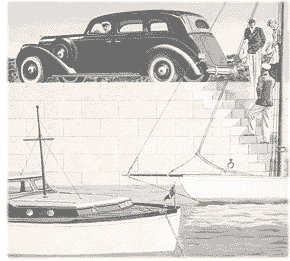 2015 Scottsdale Auctions: F. Scott Fitzgerald once wrote, "Let me tell you about the very rich. They are different from you and me. They possess and enjoy early, and it does something to them, makes them soft, where we are hard, cynical where we are trustful, in a way that, unless you were born rich, it is very difficult to understand." 2015 Scottsdale Auctions: F. Scott Fitzgerald once wrote, "Let me tell you about the very rich. They are different from you and me. They possess and enjoy early, and it does something to them, makes them soft, where we are hard, cynical where we are trustful, in a way that, unless you were born rich, it is very difficult to understand."
Yes, the rich are indeed different. Someone who pays almost $10 million for a single Ferrari does not just have one collector car. Or one Ferrari. Typically, he has a collection - 20 to 50 cars. He employs several mechanics just to care for them. Often, such folk own a tricked-out enclosed car carrier to transport their prized vehicles to shows. It's fair to assume that this person's collection is worth north of $30 million. The kind of person who has such a collection is quite rich, probably worth a half-billion or more.
This man is likely a first or second generation business owner, with a firm large enough to allow his sheet metal indulgences, including the time off to travel to auctions and hobnob with other, like-minded collectors.
This year's Scottsdale car auction week was full of such aging white dudes with lotsa money, bidding up car prices toward the stratosphere as they sought their automotive nirvana du jour. Or the nostalgia of their youth.
Not that there's anything wrong with that. In America, we celebrate success. And, if a self-made guy wants to spend his own excess cash overpaying for a shiny piece of rolling automotive art, who are we to judge? It's better than, say, giving the money to the Democratic National Committee, who - if they had their way - would have all of us driving Trabants. Or puny electric microcars. Or riding public transit.
Enabling auctioneers RM Auctions, Gooding & Co., Bonhams and Barrett-Jackson helped orchestrate January's Arizona feeding frenzy and there was, indeed, lots of frenzy this year.
RM Auctions sold a red mid-engined V12 1964 Ferrari 250 LM (body by Scaglietti) for $9,625,000. The firm also sold a 1966 Ferrari 275 GTB/2 Coupe for $2,750,000, a 1984 Ferrari 288 GTO Coupe for $2,750,000, a 1966 Ferrari 275 GTS Spyder for $2,365,000, a 1971 Lamborghini Miura SVJ Coupe for $1,897,500 and a 1962 Ferrari 250 SII Cabriolet for $1,705,000.
A race-red 1966 Ferrari 275GTB Competizione sold for a price of $9,405,000, while a 1964 Shelby 289 Cobra gaveled down for $1,017,500. A red 1955 Mercedes-Benz 300 SL gullwing coupe was sold by Bonhams for a fee-inclusive price of $1,375,000. (B-J later sold a 1955 silver 300 SL for an even million dollars.) A silver 1958 Mercedes-Benz 300 SL roadster with just 57,000 miles on the odometer crossed the block for $1,237,500.
At Gooding & Co., a red 1959 Ferrari 250 GT LWB California Spider, with coachwork by Scaglietti, sold for $7,700,000.
A 1969 Ferrari 365 GTB/4 Daytona Berlinetta fetched $748,000 at Bonhams; a 1938 Bugatti Type 57 Roadster sold for a price of $671,000, which seemed surprisingly low to me. A 1914 American Underslung 646 five-passenger touring car fetched $528,000.
Barrett-Jackson, no longer merely an auction house but a 'brand' which now also sells its own line of Barrett-Jackson auto care products including car wax, gaveled a 1969 Chevrolet Camaro COPO 427 for a whopping $330,000 as well as a jet-black 1991 Ferrari F40 for $585,000. A red 1989 F40 failed to sell at a high bid of $975,000.
The mention of those F40s triggered a memory. In the early 1990s, we often dined at the Couch Street Fish House (it closed in 2000) in the questionable neighborhood (aka - seedy, filled with drunks and drifters) of Old Town Portland. The establishment had a small valet lot and, when we arrived in my Lincoln Mark VII, the car was always buried in obscurity amongst the other vehicular iron. When I purchased my new '92 Twin Turbo Nissan 300ZX and fitted it with chrome wheels, the valets parked it right next to the door, like a piece of automotive jewelry. One evening, I exited the restaurant and found my Z buried amongst the more plebeian vehicles. It had been dethroned; a low-slung, red Ferrari F40 was parked by the door. Fame - especially automotive fame - is fleeting.
The B-J Auction was televised, providing many hours of shiny car porn to wade through. And I did. Here are some of the cars that caught my eye:
• An albino-corpse white 1934 Cadillac convertible with red interior, looking stock but with a modern Cadillac Northstar V8 powertrain, crossed the block at an astounding $400,000.
• A black 1934 Ford DeLuxe roadster fetched $150,000. It was restored over a 13-year period using NOS (new old stock) components.
• A pale yellow 1939 Packard Twelve boattail speedster with dual sidemounts was sold for only $90,000. Unfortunately, boattails generally don't look that good on late 1930s vehicles, especially a big, long one like the Twelve. This awkward example was not the best-looking Packard I've seen and that's probably why the price was lower than I would have expected.
In contrast, a Junior Packard - a 1937 120 convertible painted in pleasing gold color - also fetched $90,000. And a Brewster-bodied, black 1932 Packard 900 Light Eight roadster sold for $250,000. A black 1933 Packard Twelve custom all-weather Town Car Landaulet by LeBaron was sold by RM Auctions for $374,000. The firm also auctioned a gorgeous blue 1937 Packard Twelve coupe roadster for $319,000.
• A rare, black 1941 Chrysler Royal Town and Country six-passenger 'Barrelback' woody station wagon fetched $440,000 at RM Auctions.
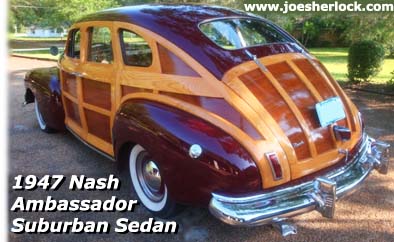 • A gorgeous burgundy 1947 Nash Ambassador woody fastback sedan found a new buyer for a mere $70,000. • A gorgeous burgundy 1947 Nash Ambassador woody fastback sedan found a new buyer for a mere $70,000.
I had never seen a Nash Suburban sedan before; fewer than 600 examples were made in '47 - compared with over 101,000 Nashes total for the year.
The Suburban sedan was the most expensive model in Nash's lineup, priced at $2,227. The car got its power from an inline six-cylinder engine, producing 112 hp.
• A handsome maroon 1947 Cadillac Series 62 convertible with a tan canvas top and tan leather interior, powered by Cadillac's flathead V8 of the period, found a new buyer at a price of $53,000. Cadillacs didn't get tailfins until 1948.
• Much has been written about the GM Futureliners - bus-like vehicles which carried the General Motors 'Parade of Progress' product showcase to towns across America in the early 1950s. A 1950 Furtureliner bus was sold for $4 million.
It was owned by Ron Pratte of Phoenix, founder of Pratte Development Company - one of the biggest wood framing and concrete foundation companies in the U.S. Pratte is liquidating his extensive car collection and donated the proceeds from the Futureliner sale to the Armed Forces Foundation, an organization that works to support injured troops and military families, especially those afflicted by post-traumatic stress disorder and traumatic brain injury.
• A newly-restored, sleek 1951 red Jaguar with rear wheel spats and a bright white leather interior sold for $68,000. Someone just got a gorgeous, driveable metal sculpture for a very good price.
• A classy-looking red 1953 Mercedes-Benz 300S cabriolet with the chromed factory landau bars and saddle interior went under the hammer for $585,000.
• An arrest-me-red 1954 Cadillac Eldorado convertible - the subject of a two-year, frame-off restoration and looking every bit like it - with a red leather interior brought the hammer down for $155,000, which sounded like a fair price for both seller and buyer.
• A Polo White 1954 Corvette with a tan canvas top and red interior brought $92,000. A few minutes later, an almost identical one fetched $88,000.
While these cars are historically interesting, they are neither fast nor sporty. The Chevy stovebolt six motor coupled with Powerglide - no manual trannys were available on the '54 Vettes - made for a real slug of a car.
• It is not often that a General Motors' Motorama show car appears on the auction block but a one-of-a kind 1954 Pontiac Bonneville Special concept car was auctioned by Barrett-Jackson. The fiberglass bodied, Corvette-like Pontiac two-seater featured Pontiac's straight engine and a bubble top. Only two were produced - one in bronze and one in metallic green. The green one fetched $3,000,000 over the weekend.
I've never seen the real car but I do have a model of it:
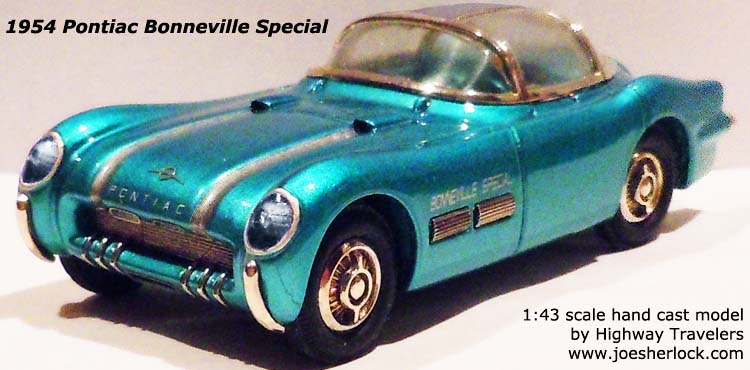
• At RM Auctions, a pale yellow 1954 Kaiser-Darrin roadster sold for $176,000.
• A red and cream 1955 Woodill Woodfire fiberglass roadster powered by a Buick nailhead V8 sold for a mere $16,000. This was one of a handful of factory-built cars; most Woodfires were sold as kits.
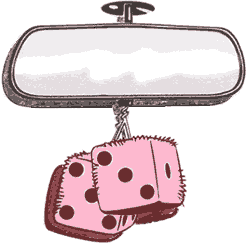 • A 1956 customized silver and black 1956 Chevy Nomad with a 5.7-liter crate motor gaveled down at an amazing $250,000. To most collectors, the '56 is the ugly sister of the '55-57 Nomad trio, so the high selling price for this example surprised me. • A 1956 customized silver and black 1956 Chevy Nomad with a 5.7-liter crate motor gaveled down at an amazing $250,000. To most collectors, the '56 is the ugly sister of the '55-57 Nomad trio, so the high selling price for this example surprised me.
• A white 1956 Continental Mark II with factory A/C and the same red/white interior as my old '57 Mark went under the gavel for $72,000. In their day, these cars cost more than three times as much as a Thunderbird and they're much rarer, too. Over two model years, only 3,000 Mark IIs were manufactured. Over three model years, Ford sold over 53,000 two-seater T'Birds. Yet, equivalent-condition two-seat Thunderbirds have always commanded higher prices at auction.
Later, a black 1956 Mark II resto-rod with red interior, a modern Ford 427 cu. in. aluminum V8 engine and big custom wheels was sold for $95,000. Another 1956 black Mark II without air-conditioning and missing a wheelcover sold for $39,000. A really good Mark II wheelcover can cost well over $500.
At RM Auctions, it was a different story: A rare dark red fully-restored 1956 Continental Mark II - with an interior featuring matching two-tone maroon and white leather upholstery but no A/C - found a buyer at $247,500. Amazing.
• A newly-restored, fire engine red 1956 Ford Thunderbird with the standard 312 cu. in. V8 and Ford-O-Matic automatic transmission fetched $83,000.
• A red 1957 Cadillac Eldorado Biarritz convertible (with red interior) sold for $142,000. The very next car on the B-J auction block was a jet black 1958 Cadillac Eldorado Biarritz convertible, which fetched $125,000. A metallic green 1959 Cadillac Eldorado Biarritz sold for $160,000. Were these price differences due to color preference, model year preference or random fate? I dunno.
• A 1957 pale green Chevrolet Bel Air convertible with a two-barrel-carbed, 283 cu. in. V8 and Powerglide sold for a whopping $175,000. Later, a tricked-out resto-rod, triple-black '57 Bel Air convertible fetched an even more outrageous $235,000.
• A 1957 DeSoto Adventurer convertible, finished in cream over gold sold for $180,000. The car was powered by a 345 cu. in Hemi V8 and showed 82,000 original miles. No one wanted DeSotos when Chrysler made 'em; now they're a hot auction item.
• A freshly-restored, dusky-rose 1957 Ford Thunderbird 'E', with the dual-quad carb setup sold for $200,000.
• A white over dusky rose 1957 Ford Skyliner retractable hardtop fetched $100,000.
• A 1960 Fiat Multipla van crossing the block at Barrett-Jackson reminded me of my diecast souvenir from our trip to Italy:
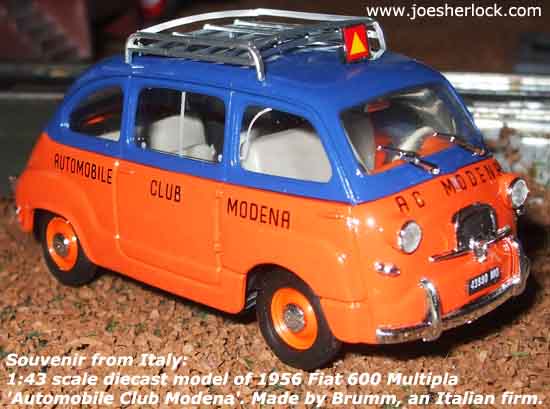
The Multipla at the auction was green over black and sold for $32,000.
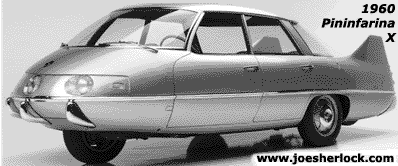 • The distinctive but odd-looking 1960 Pininfarina X concept car - looking like a three-wheeled sedan but with its four wheels arranged in a diamond pattern (one in front, two in the middle and one in the back) in a quest for aerodynamics - was auctioned off with a winning bid of $300,000. That's quite a comedown from the original $3 million asking price. • The distinctive but odd-looking 1960 Pininfarina X concept car - looking like a three-wheeled sedan but with its four wheels arranged in a diamond pattern (one in front, two in the middle and one in the back) in a quest for aerodynamics - was auctioned off with a winning bid of $300,000. That's quite a comedown from the original $3 million asking price.
I saw the Pininfarina X in person at the New York Auto Show in the 1960s. The four-door sedan looked even stranger in person than in photographs.
• A nicely-restored, Indigo Blue 1961 Jaguar XKE convertible commanded a price of $160,000. An early-production, California-destination car, it was originally owned by a Palm Springs resident.
• A bright red 1961 Chrysler 300G hardtop with off-white interior crossed the block for $200,000 - surprising, since the G isn't the most desirable of the 300 series. Earlier in the week, RM Auctions sold a red 1955 Chrysler C-300 hardtop coupe for $126,500.
• A gorgeous black Chrysler-powered 1961 Ghia L6.4 Coupe was auctioned by RM Auctions and sold for $412,500. Described as the "ultimate Dual Ghia," only 26 examples were built. Frank Sinatra owned one, so did Lucille Ball.
• A very nice-looking triple-black 1963 Lincoln Continental four-door convertible sold for $55,000.
• A green 1967 Austin-Healey 3000 commanded an auction price of $100,000, which seemed expensive to me. Then I saw another one go across the block - a freshly-but-incorrectly restored silver 1964 example - for $92,000. Hmmmm - maybe it's my value meter that's outta whack.
• A light blue 1967 Chevrolet Camaro Z28 coupe sold for $180,000. This was the first year of the Camaro and the first year of the Z28. Later a 'hot' option, the Z28's built in 1967 carried no external identification other than wide racing stripes. Convertibles could not be ordered with the ZZ8 option and volume was low (only 602 made), making this a rare car.
• A 1967 Volkswagen 21-window Microbus went under the gavel at $112,000 at Barrett-Jackson. RM sold a 1962 Volkswagen Type 2 Westfalia Camper for $110,000.
There are apparently lots of rich, nostalgic hippies to bid up prices on these old haulers. VW buses used to be the butt of jokes; at a hundred grand a pop, no one is laughing anymore.
• A restored beige 1968 Toyota Land Cruiser FJ-45 pickup truck was sold by B-J for $50,000. RM Auctions sold a 1966 Toyota FJ40 Land Cruiser for $49,500.
• A red 1969 Corvette coupe with the L88 performance package gaveled down at $450,000.
• A silver 1969 Pontiac Firebird Trans Am coupe - one of several pre-production prototypes built - brought down the hammer at $285,000.
• A red (with white accents) 1971 Oldsmobile 442 convertible found a buyer at $100,000. Barrett-Jackson's stage was littered with various muscle cars for sale: Shelby Mustangs, Camaros, Chevelles, GTOs, Barracudas, Challengers, Superbirds, Road Runners and the like. It seemed like every other car was either a ponycar or a muscle car. Or a pre-1973 Corvette.
People who lusted after these cars as ten year-olds (while playing with Hot Wheels versions of them) are now in their 50s and are experiencing the joys of disposable income, thus driving up demand for these big, roadworthy Hot Wheels toys.
There weren't too many bargains at this year's Arizona moneyfest. Times are good and the wealthy don't seem to have a care in the world. They're different from you and me. (posted 1/19/15, permalink)
Selling Fords: My dad bought his 1956 Ford Mainline Tudor sedan from Alvin A. Swenson Ford, which claimed to be the 'Largest Ford Dealer in the Northeast' (the slogan vaguely hinted at the largest in the NE United States, although the boast probably referred to the Northeast section of Philadelphia).

Swenson had been around for a long time; a 1922 ad noted ... (more >>>)
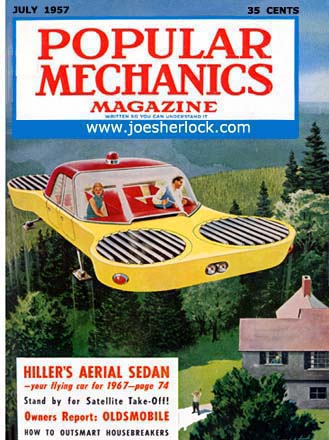 2015 Detroit Auto Show: As regular readers know, the first auto show I ever attended was the 1960 Philadelphia Auto Show in November 1959. 2015 Detroit Auto Show: As regular readers know, the first auto show I ever attended was the 1960 Philadelphia Auto Show in November 1959.
Ever since then, I have faithfully followed auto show coverage because I wanted to see what the future held by looking at all the wild concept cars on display. Alas, I continue to be disappointed by the lack of far-out machinery, such as bubble-topped flying cars, powered by nuclear turbine engines, at this year's Detroit Auto Show.
When I was growing up, magazines like 'Popular Mechanics' and 'Mechanix Illustrated' predicted that tires and roads would soon be obsolete and we'll get around in flying cars with Plexiglas roofs. Never happened.
While there were no bubble-topped, flying cars to be seen at this year's Detroit show - the one precociously renamed the North American International Auto Show, there were some new model introductions that caught my interest:
• Ford introduced a new mid-engined GT supercar. Instead of the atmospheric V8 in the original or the supercharged one in the 2005 retro revival, the new GT packs a 3.5-liter twin-turbo V6 nestled in the middle of its wheelbase and driving "more than 600 horsepower" to the rear wheels. The style looks quite contemporary and knife-edgy but there are enough styling elements to give it the pleasant whiff of the old GT40 while being larger and more big-people accommodating all around. The newest GT will enter limited production in late 2016.
• The 2016 Lincoln MKX SUV is "inspired by airplane design," says Lincoln (Which airplane? The Ford Trimotor?), but it just looks like a big brother to the little MKC, featuring HID lights with those now-ubiquitous LED accents, a panoramic glass roof, a hands-free power liftgate and a 360-degree camera. It is powered by a 330 horsepower V6 hooked to a six-speed automatic.
• New vehicles from the upmarket Germans included a sporty fastback SUV from Mercedes-Benz, the GLE Coupe as well as a big, boxy, squared-off, vaguely Asian-looking Q7 SUV from Audi and a smooth, restyled BMW 6-series range, comprising of a two-door coupe, a convertible and a four-door Gran Coupe.
• GM's Buick introduced the 2016 Cascada, a small convertible borrowed from the GM's Opel/Vauxhall Astra line. Generally well received in Europe and Buick's first convertible in 25 years or so, the question is whether the chubby little four-cylinder, front-driver will be a well-received addition to the line or rental car fodder in sunny climates.
On our last trip to Ireland, we rented a red Astra. It wore Opel badges - a virtual Deutschland twin of the British Vauxhall model. The rental Astra was a pleasant little car - with reasonable pep. Then someone rear ended us and its trunk wouldn't stay shut. This became very inconvenient as we couldn't secure our luggage. I began referring to the little Opel as a Pain-in-the-Astra.
• Infiniti showed a concept coupe called the Q60; it is supposedly a preview of the next gen G35/73 whatever-it-was coupe. It has Infiniti-sleek styling, a twin-turbo V6 - shades of my ol' 300ZX - and fugly black wheels. Infiniti says the Q60 that will go on sale next year will be "strongly influenced" by the Q60 concept.
• Jaguar has announced that it is getting into the truck business, revealing the name of its new 'performance crossover'. It will be called "F-Pace," an odd moniker. It will also have five seats, Instinctive All Wheel Drive (Instinctive?) and All Surface Progress Control (sounds like an ArmorAll slogan) for handling "unkind elements." (Terrorists? Agressive panhandlers? Teddy boys?)
I thought a Jaguar truck was called a Land Rover.
• The 2016 Chevrolet Volt looks sleeker than the old one and - to me - more Prius-like. It appears longer than its 180 inches. A 50-mile EV range is claimed, as well as 41 mpg and seating for five, if you're on the small side. The new Volt is supposed to arrive in dealerships during the second half of 2015.
• On the other hand, there's the little Volt quasi-CUV, known unimaginatively as the Chevrolet Bolt. (Perhaps the next model in the lineup will be the Chevy Dolt.) The $30,000 EV crossover concept boasts a range of 200 miles, though no specific powertrain has yet been mentioned. DC fast-charging is supported. The weirdly-styled Citroen-like vehicle is supposed to go into production in 2017.
• Acura debuted its latest mid-engined NSX - in red, of course - powered by a longitudinally-mounted, turbocharged, dry-sump V6 that produces "north of 550 horsepower," according to Acura. As before, the internal combustion mill works with three electric motors to deliver power to all four wheels. Super Handling All-Wheel Drive, indeed – or, as Acura refers to it in this application, Sport Hybrid Super Handling All-Wheel Drive.
They were originally going to call it 'Wow Sailor Moon Big Deal America Sport Hybrid Super Handling Hello Kitty USA-USA Sanosuke Sagara All-Wheel Drive Pokemon Awesome Crazy Fun' but it wouldn't fit on the front of the brochure.
It doesn't look as good as the original NSX and lacks that sought-after supercar panache but will sell for $150,000 and up. Orders will be taken starting this summer. The NSX will be assembled by 100 employees at Honda's Super Awesome Manga Performance Manufacturing Center in Marysville, Ohio.
• The Buick Avenir is a four-door, four-seater concept car. It's a big automobile, over 204 inches long and has a pseudo-boattail fastback shape. Like the Ford GT, it's powered by a V6 engine. Buick claims that it's "a flagship sedan exploring progressive design with new levels of passenger well-being and technology integration." This translates to mouthful of cliches epoxied together to form an incoherent sentence which describes nothing. It's a nice-looking concept, though.
• Cadillac unveiled its 2016 CTS-V performance sedan, with a 640-horsepower supercharged 6.2-liter V8. Torque is 630 lb-ft, top speed is claimed to be 200 mph and 0-60 comes in 3.7 seconds. A paddle-shifted eight-speed automatic with launch control is standard.
I'd sooner buy a Corvette.
• Alfa Romeo introduced a droptop Spider version of its 4C sports car, a mid-engine, Italian convertible. But the top is manually operated, Tony, so no buttons-a-pusha to maka-da-top go down. Only 3,000 4Cs will be built in Italy and fewer than half will be the convertibles. Like Jaguar, Alfa plans to offer a crossover vehicle soon, further diluting what's left of the brand's sporty image.
• Hyundai debuted the HCD-15 Santa Cruz compact pick-em-up-truck, kinda like the ol' Honda Ridgeline. The HCD-15 is just a concept at this point. In an oddly clueless statement, Hyundai claimed that the vehicle "meets the unspoken needs of a growing Millennial lifestyle we call 'Urban Adventurers'," whatever the hell that is. Most Millennials are currently riding bicycles or driving shabby old subcompacts with faded paint. Kinda like Third World Urban Adventurers.
• The Volvo S60 Inscription sedan will be the first Chinese-made car to be sold in the U.S. Volvo is building the large sedan at its plant in Chengdu, China. It will be interesting to see what Consumer Reports says about this Volvo's quality/reliability a year or two from now.
• One of the most peculiar vehicles at the show was the hideous-looking Spira4u foam car. Done up in red and gray, it looked like it was designed by a four year-old who was given a very limited number of Crayolas. It has the look of a bumper car made for the developmentally-disabled. The exterior is made of expanded polypropylene foam over a fiberglass honeycomb and the Spira4u sports only three wheels - one in the front and two in the back. Anyone remember Jeremy Clarkson's adventures with the Reliant Robin on 'Top Gear'?
Pilot production is reportedly already underway, perhaps at Wham-O or Hasbro's nerf ball factory.
Supercars like the new Ford GT and Acura NSX set the tone for this year's auto show, which is heavy on performance and advanced technology. While some years have been dominated by fuel-saving hybrids or practical, family-friendly sedans, 2015's theme is all about driving fast and having fun behind the wheel. The U.S. auto industry, which sold 16.5 million units in 2014, is expecting more growth in 2015, thanks to easy credit and cheap gas. Some forecasters say auto sales could approach 17 million units this year.
Still waiting for that flying car, though. (posted 1/14/15, permalink)
Take The Bus Benz And Leave The Driving To Us: At the Consumer Electronics Show last week, Mercedes-Benz debuted its Luxury in Motion concept, M-B's vision for autonomous driving. The vehicle "provides a concrete example of the visionary ideas the company is developing with regard to autonomous driving of the future," proclaimed the company enthusiastically. With this self-driving luxury sedan, Mercedes-Benz, "illustrates how the car is growing beyond its role as a mere means of transport and will ultimately become a private retreating space. This new way of traveling gives passengers the freedom to use their valuable time on the road in manifold ways." Plus, robot cars are cool and will impress your friends, even your Facebook ones.

"Anyone who focuses solely on the technology has not yet grasped how autonomous driving will change our society. The car is growing beyond its role as a mere means of transport and will ultimately become a mobile living space," explained Dr. Dieter Zetsche, Chairman of the Board of Management of Daimler AG, Head of Mercedes-Benz Cars and former Doctor Z of Chrysler, the latter being something he probably doesn't include in his LinkedIn profile.
Mmmmmkaay. The futuristic Benz looks like something from 'Judge Dredd'.
Audi, however, chose to have its self-driving A7 drive itself to Las Vegas from Palo Alto, California.
Like it or not, self-driving cars are on their way. Other companies showed off their self-driving technologies. Using an Audi, Delphi Electronics showed off its self-driving technologies to reporters on Las Vegas city streets. Bosch, Valeo, and Nvidia also showed their versions of self-driving software and hardware. These cars will cost a bunch; don't expect to see a self-driving Kia Rio anytime soon.
The coolest thing at CES wasn't a car; it wass was the 3DMe Photobooth by 3D Systems. Looking a bit like an updated edition of an old-time photo booth, it creates a three-dimensional portrait and generates a miniature six-inch tall figurine in 15 seconds. You can also have your head put on other bodies such as Star Wars figures and other licensed characters.
As for self-driving cars, I'm holding out for something less expensive. If this were the Good Old Days, J.C. Whitney would already be offering an Amazing Self-Driving Conversion Kit in their catalog for $49.95. "E-Z to install - takes only minutes! No special tools required! Fits all cars except Hudson and Kaiser."
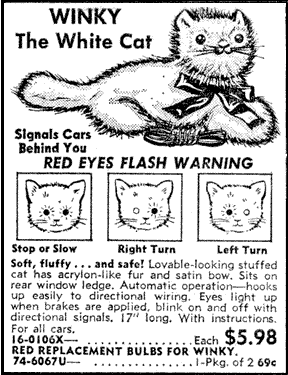
Yeah, send me one of those ... and a Winky the Cat, too. (posted 1/12/15, permalink)
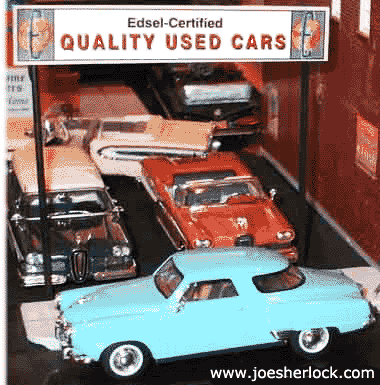 2014 Auto Sales Wrap-Up: In calendar year 2014, U.S. auto sales rose 6% to just over 16.5 million vehicles. The market supported more than 16 million sales for the first time 2007 with strength rising most particularly in the SUV/crossover sector, but also from top-selling cars. Toyota's Camry, the best-selling car in America, climbed to 428,606 sales. The Nissan Altima set an annual sales record. The Honda Accord reached a seven-year sales high. 2014 Auto Sales Wrap-Up: In calendar year 2014, U.S. auto sales rose 6% to just over 16.5 million vehicles. The market supported more than 16 million sales for the first time 2007 with strength rising most particularly in the SUV/crossover sector, but also from top-selling cars. Toyota's Camry, the best-selling car in America, climbed to 428,606 sales. The Nissan Altima set an annual sales record. The Honda Accord reached a seven-year sales high.
Brands which recorded record-breaking sales last year included Subaru (+21%), Porsche (+11%), Nissan (+12%), Kia (+8%), Mercedes-Benz (+7%), Maserati (+171%), Land Rover (+3%), Honda (+1%), Hyundai (+1%), BMW, (+10%) Audi (+15%), Jeep (+41%) and Ram (+28%).
2014's drop in gas prices helped fuel truck sales and starve sales of the Chevy Volt (down 19% for the year) and Toyota Prius (-12%). True eco-believers, mostly aging, politically-correct ex-hippies, were so so upset that they went and hung themselves in the nearest gender-neutral bathroom.
Tesla is estimated to have sold 26,400 vehicles in 2014, mostly to fashionistas, Hollywood types and wealthy hi-tech hipster dudes.
General Motors Corporation reported sales of 2,935,008 units, up over 5% for the year. Buick and GMC each had sales increases over 10% but Cadillac was its big disappointment; sales of the luxury brand fell 6.5% to 170,750 Caddies. Given Cadillac's tainted rep combined with high pricing, trying to increase sales is like pushing a dumpster through a magnet factory.
Ford Motor Company reported a sales decline of 0.6% to 2,471,315 vehicles, primarily because the new Ford F-series trucks are now just becoming available. Lincoln sales rose 15.6% to 94,474 vehicles, helped mostly by SUV/CUV sales - the Navigator and the new MKC. Most other Lincoln models saw substantial sales declines.
Toyota Motor Corp. sold 2,373,771 vehicles in the U.S. in 2014 - a gain of 6.2%. Lexus sales jumped 13.7% to 311,389 examples. Lexus outsold Mazda, which only found buyers for 305,801 vehicles, an increase of 7.7% over last year. Scion is becoming Toyota's Edsel, with sales dropping over 15% to 58,009. (During the 1958 model year, 63,110 Edsels were produced.)
Chrysler Group (FCA) reported a sales jump of over 16%, helped mostly by its Jeep and Ram brands. Dodge fell 3.7% to 574,155 autos. This continues to fuel those rumors that Dodge is on its deathbed.
Nissan Motor's sales increased 11.1% to 1,386,895 units, while Volkswagen Group's sales declined by almost 3% to 598,991 vehicles. Sales of Volkswagens dropped by 10% in 2014 to 366,970 units. American Honda sold 1,540,872 units - a gain of 1%.
Maserati sales jumped 171% in 2014 to 12,943 autos, while Jaguar sales dropped 7% to 15,773 autos. Subaru continued its solid march of growth, selling over 500,000 vehicles last year in the U.S.
Mini sales dipped a whopping 15.6% to 56,112 autos. Too many models, methinks, which confuses prospective buyers. Apparently, Mini thinks so too; it has decided to discontinue three slow-selling models in its lineup - the Coupe, Roadster and Paceman. I don't even know what a 'Paceman' is. Is it a type of arcade game? Is there a Ms Paceman?
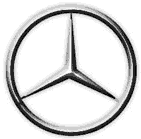 Mercedes and BMW duked it out again for top luxury spot this year. According to a report in Bloomberg News, annual U.S. sales for Munich-based BMW rose 9.8% to 339,738, allowing the brand to win back the title it lost to Mercedes in 2013. Mercedes, hampered early in the year by limited inventory for its popular CLA sedan, finished with 330,391, up 5.7%. Audi found 182,011 buyers for its offerings - an increase of 15.2%. Mercedes and BMW duked it out again for top luxury spot this year. According to a report in Bloomberg News, annual U.S. sales for Munich-based BMW rose 9.8% to 339,738, allowing the brand to win back the title it lost to Mercedes in 2013. Mercedes, hampered early in the year by limited inventory for its popular CLA sedan, finished with 330,391, up 5.7%. Audi found 182,011 buyers for its offerings - an increase of 15.2%.
The BMW 3 & 4 Series were the top-selling luxury models in the U.S. for 2014 (142,232 autos, up 19%), followed by the Lexus RS (107,490 vehicles, up 3%).
In the near-luxury field, Infinity sales were up slightly to 117,330 units (+0.8%), while Acura sold 167,842 vehicles - mostly SUVs/crossovers - an increase of 1.5%. Audi now outsells Acura, Cadillac, Infiniti and Lincoln in the marketplace.
Finally, 3003 new Bentleys found homes in 2014, an increase of 1.3% over last year.
More annual sales data can be found here. (posted 1/7/15, permalink)
Earlier Car Musings can be found here.
Other Pages Of Interest
| blog: 'The View Through The Windshield' |
| greatest hits: various essays & articles | blog archives | '39 Plymouth | model train layout |
| about me | about the blog | e-mail |
copyright 2015-21 - Joseph M. Sherlock - All applicable rights reserved
Disclaimer
The facts presented on this website are based on my best guesses and my substantially faulty geezer memory. The opinions expressed herein are strictly those of the author and are protected by the U.S. Constitution. Probably.
Spelling, punctuation and syntax errors are cheerfully repaired when I find them; grudgingly fixed when you do.
If I have slandered any brands of automobiles, either expressly or inadvertently, they're most likely crap cars and deserve it. Automobile manufacturers should be aware that they always have the option of trying to change my mind by providing me with vehicles to test drive.
If I have slandered any people or corporations, either expressly or inadvertently, they should buy me strong drinks (and an expensive meal) and try to prove to me that they're not the jerks I've portrayed them to be. If you're buying, I'm willing to listen.
Don't be shy - try a bribe. It might help.
|
|